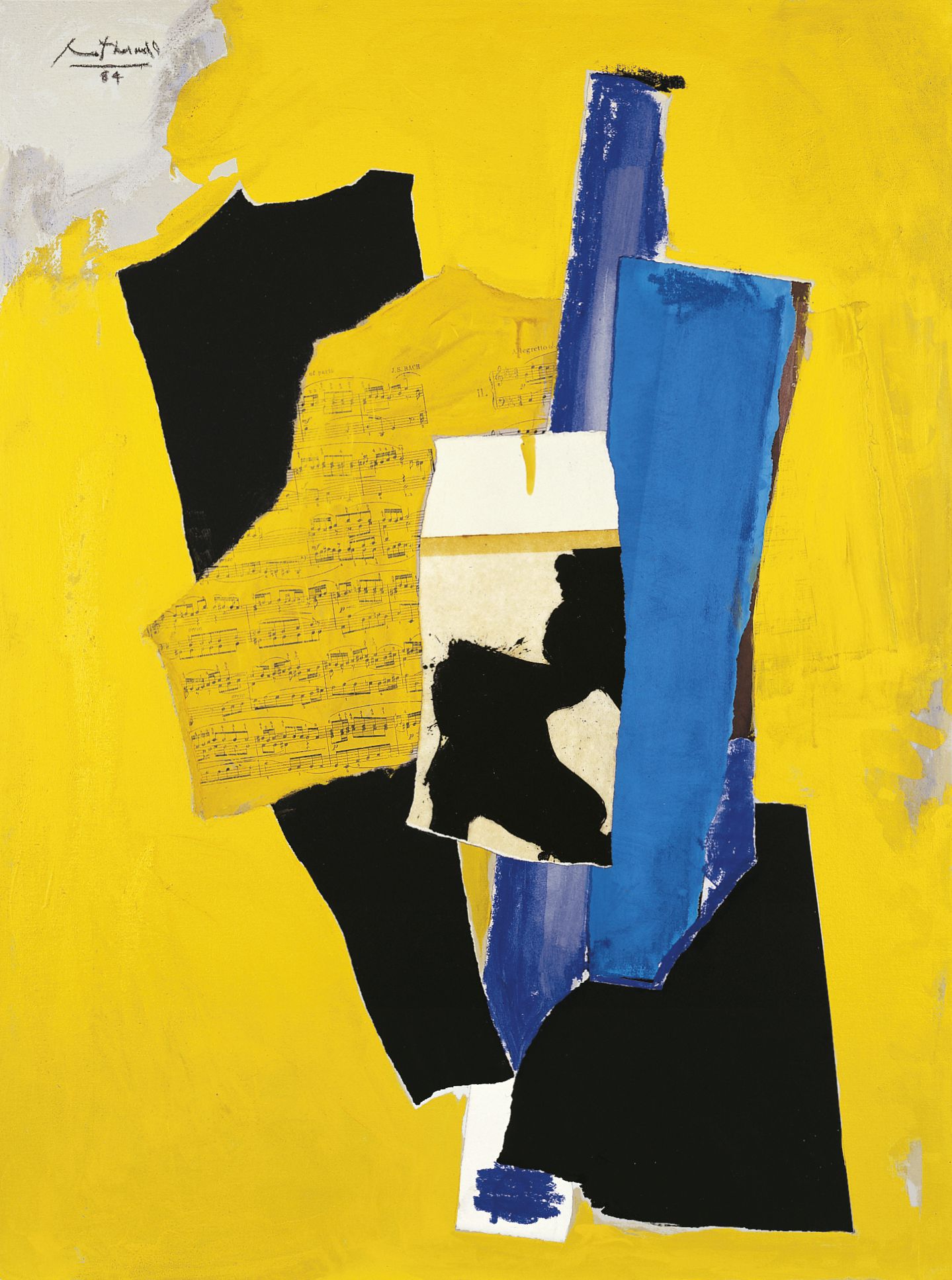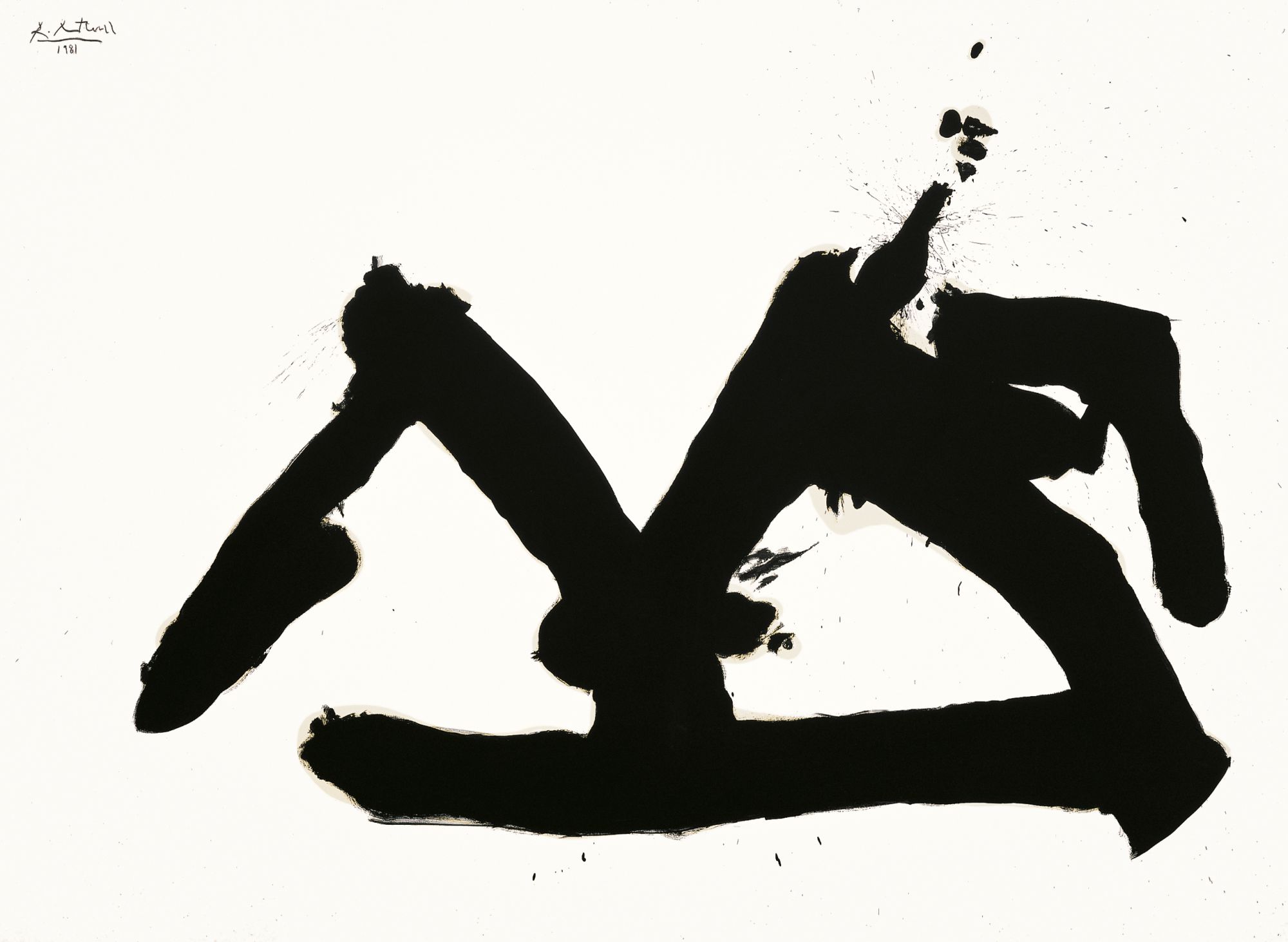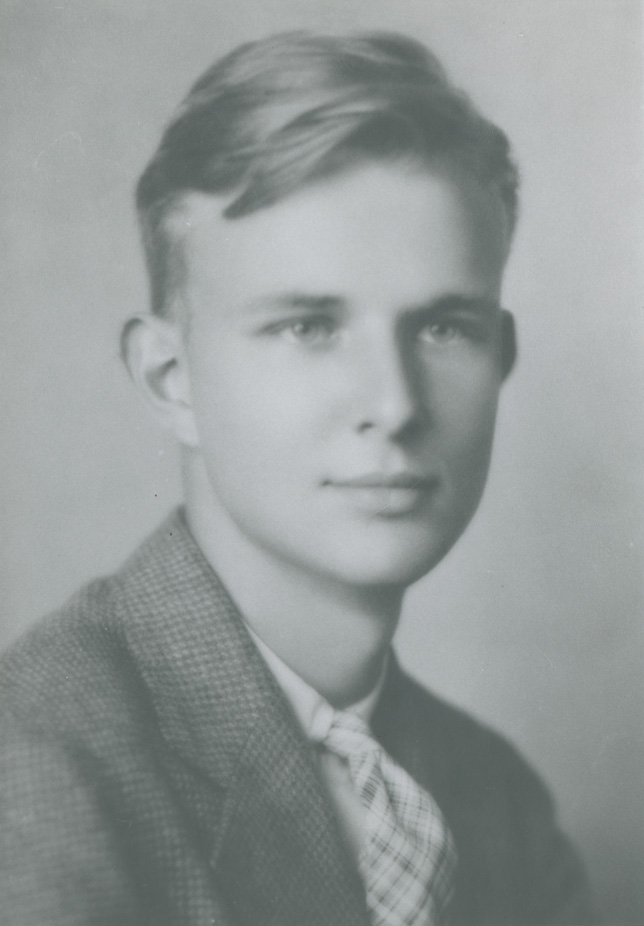Your browser is out-of-date!
Update your browser to view this website correctly. Update my browser now
1980 - 1991
Monumental Late Works
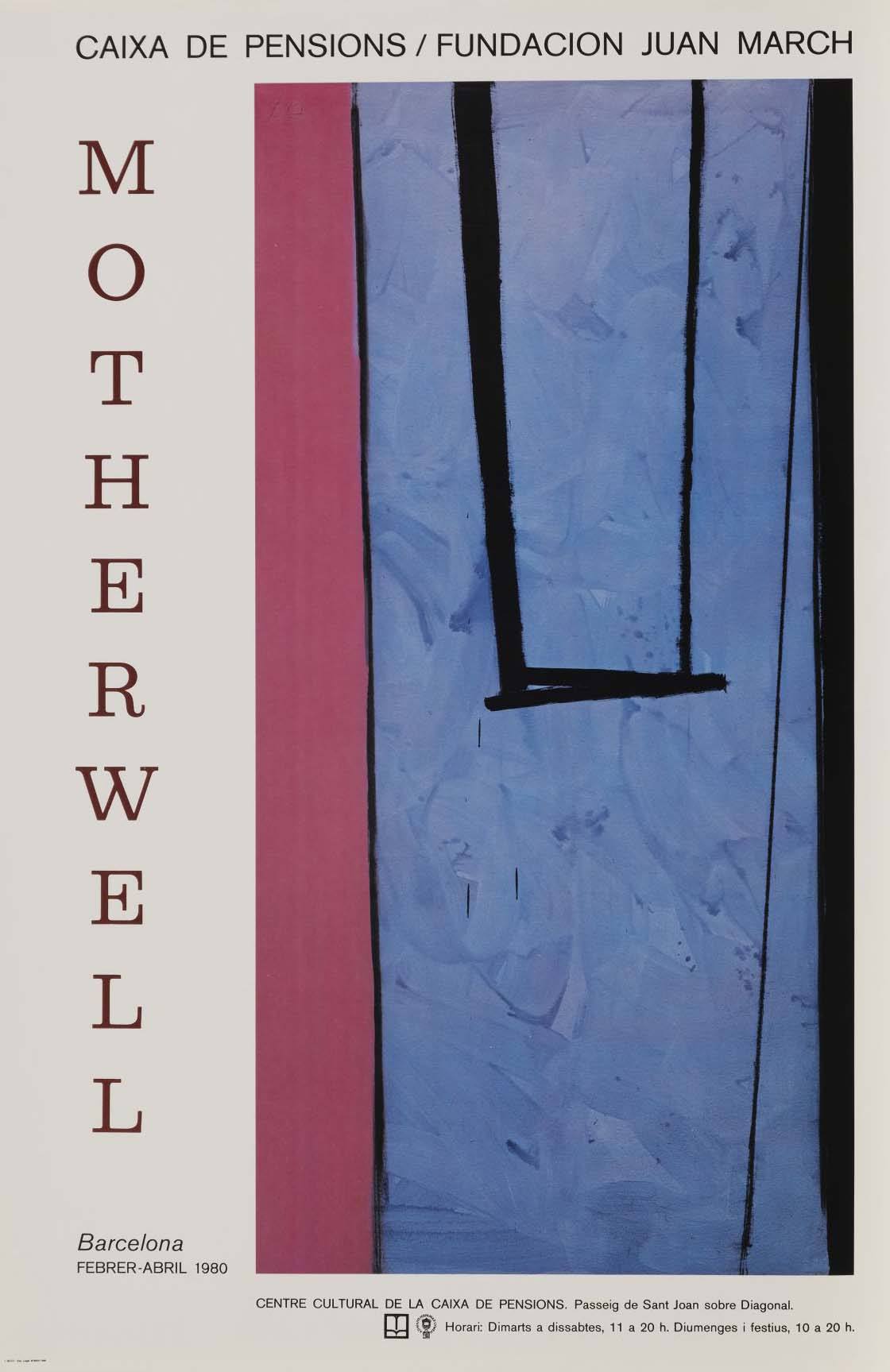
Poster from Motherwell at the Centre Cultural de la Caixa de Pensions, Barcelona, and The Fundación Juan March, Madrid, 1980
1980
In February, Motherwell, a survey of his career, opens at the Centre Cultural de la Caixa de Pensions, Barcelona, his first solo exhibition in Spain. The exhibition travels to Madrid, where it is shown at the Fundación Juan March.
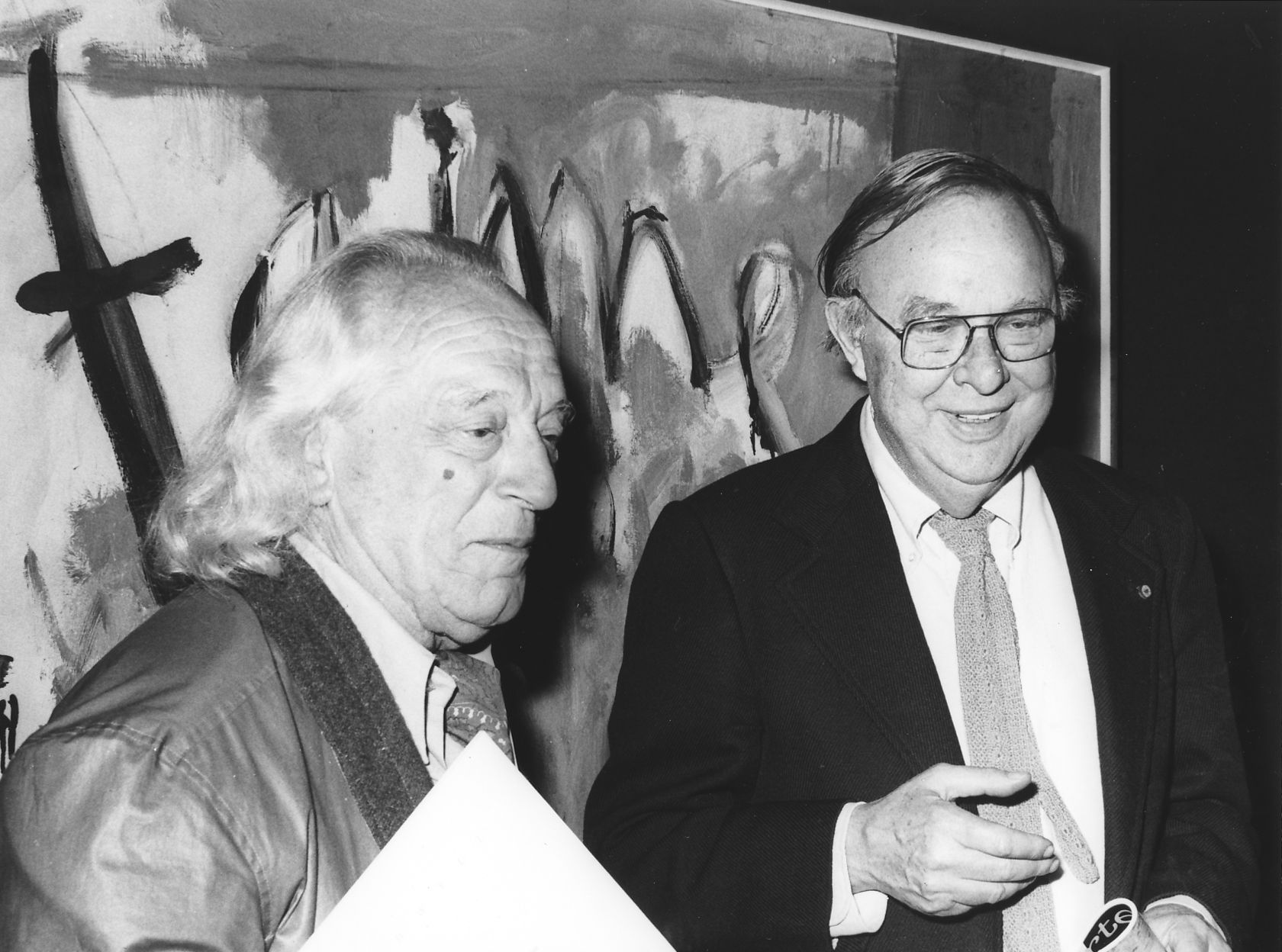
Motherwell and Rafael Alberti at Motherwell’s solo exhibition opening in Madrid, 1980
1980
At the opening in Madrid, the poet Rafael Alberti reads a new poem written for the occasion, “El Negro Motherwell.” This is Motherwell’s first meeting with the heroic poet of the Generation of ’27 and author of “A la Pintura.” The next day, the two meet in private and agree to a collaboration that results in the livre d’artiste, El Negro (1983).
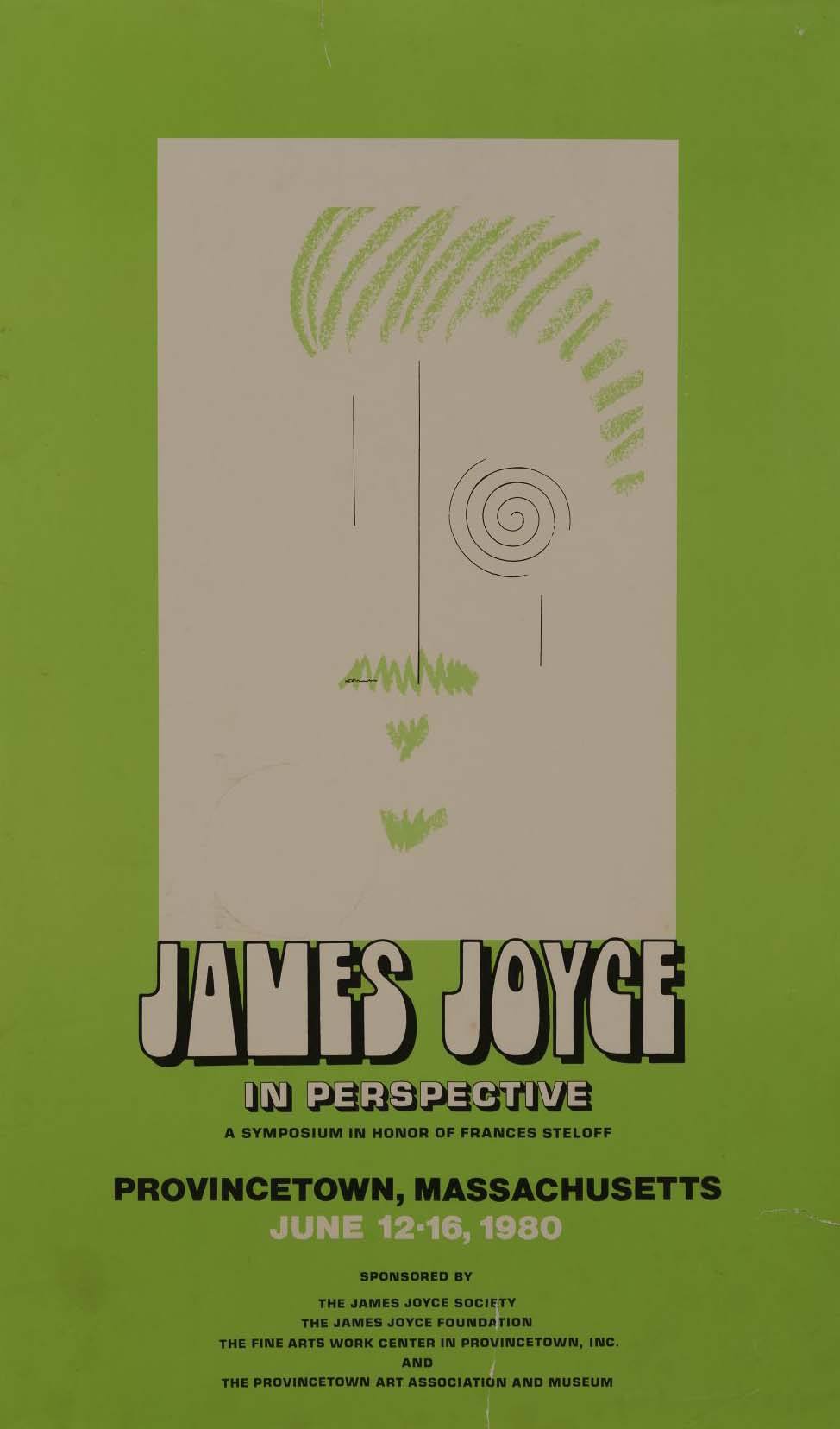
Poster for the International James Joyce Foundation’s annual meeting, Provincetown, Mass., 1980
1980
In Provincetown, Motherwell attends the International James Joyce Foundation’s annual meeting, where he participates in a panel discussion with Nathan Halper and B.H. Friedman. The experience triggers a renewed interest in Joyce, evident in his works of the next year.
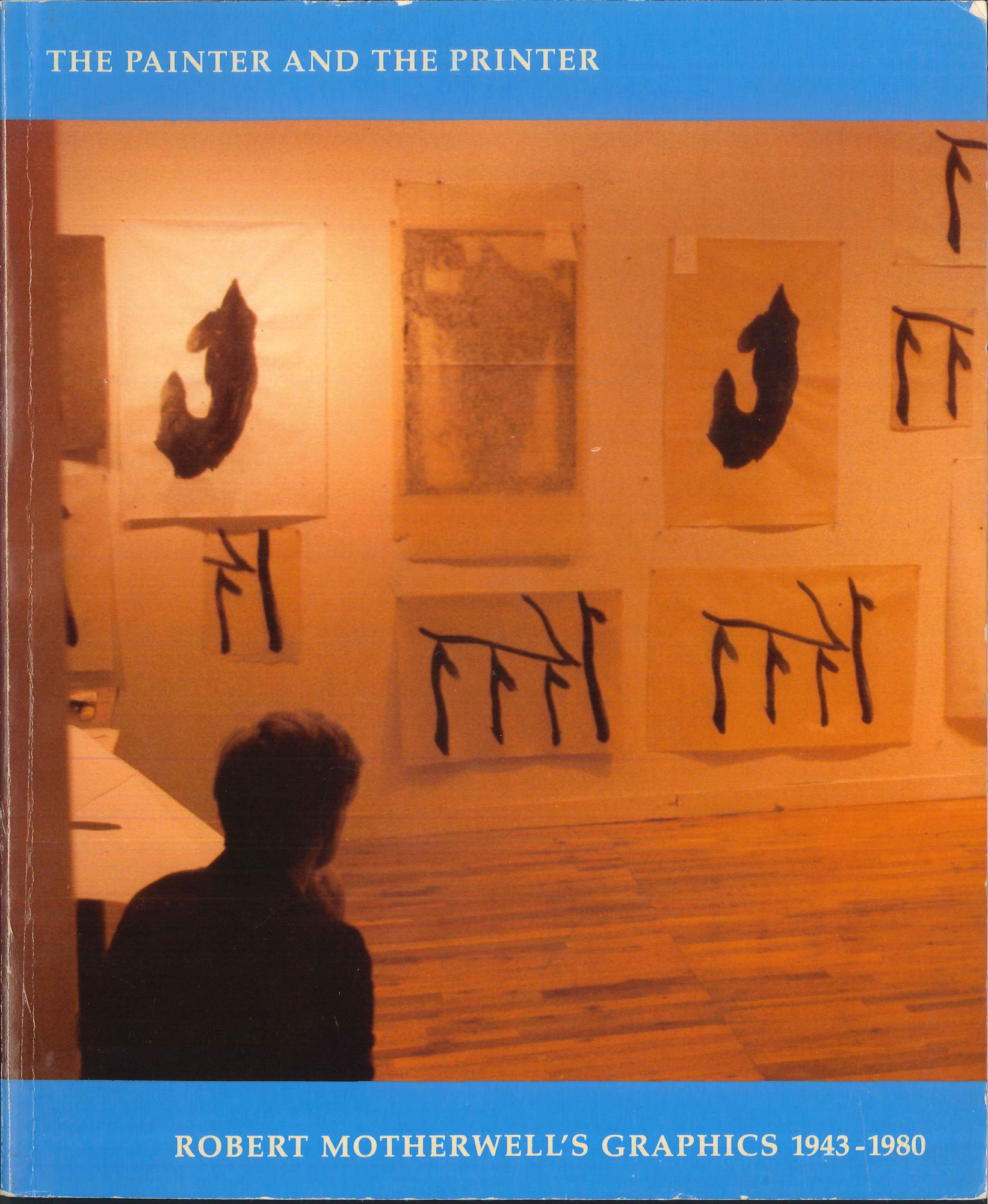
Cover of The Painter and the Printer: Robert Motherwell’s Graphics: 1943–1980, 1980
1980
The Painter and the Printer: Robert Motherwell’s Graphics: 1943–1980, by Stephanie Terenzio and Dorothy Belknap, is published by the American Federation of the Arts; the volume includes Motherwell’s essay “A Note by the Artist: On Collaboration.”
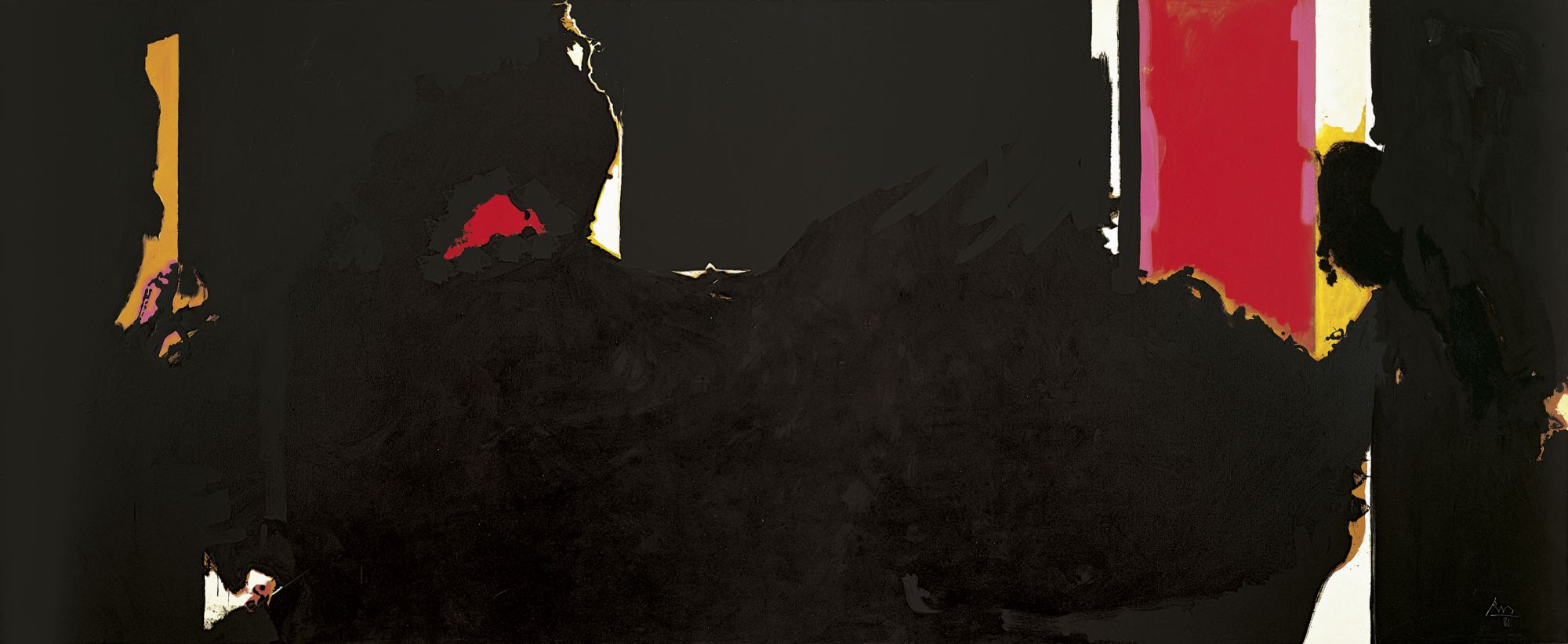
The Face of the Night (for Octavio Paz) 1977–1979/1981. Acrylic on canvas, 72 x 190 inches (182.9 x 457.2 cm)
1981
Motherwell completes ten paintings, including Face of the Night (For Octavio Paz) and Blue Elegy.
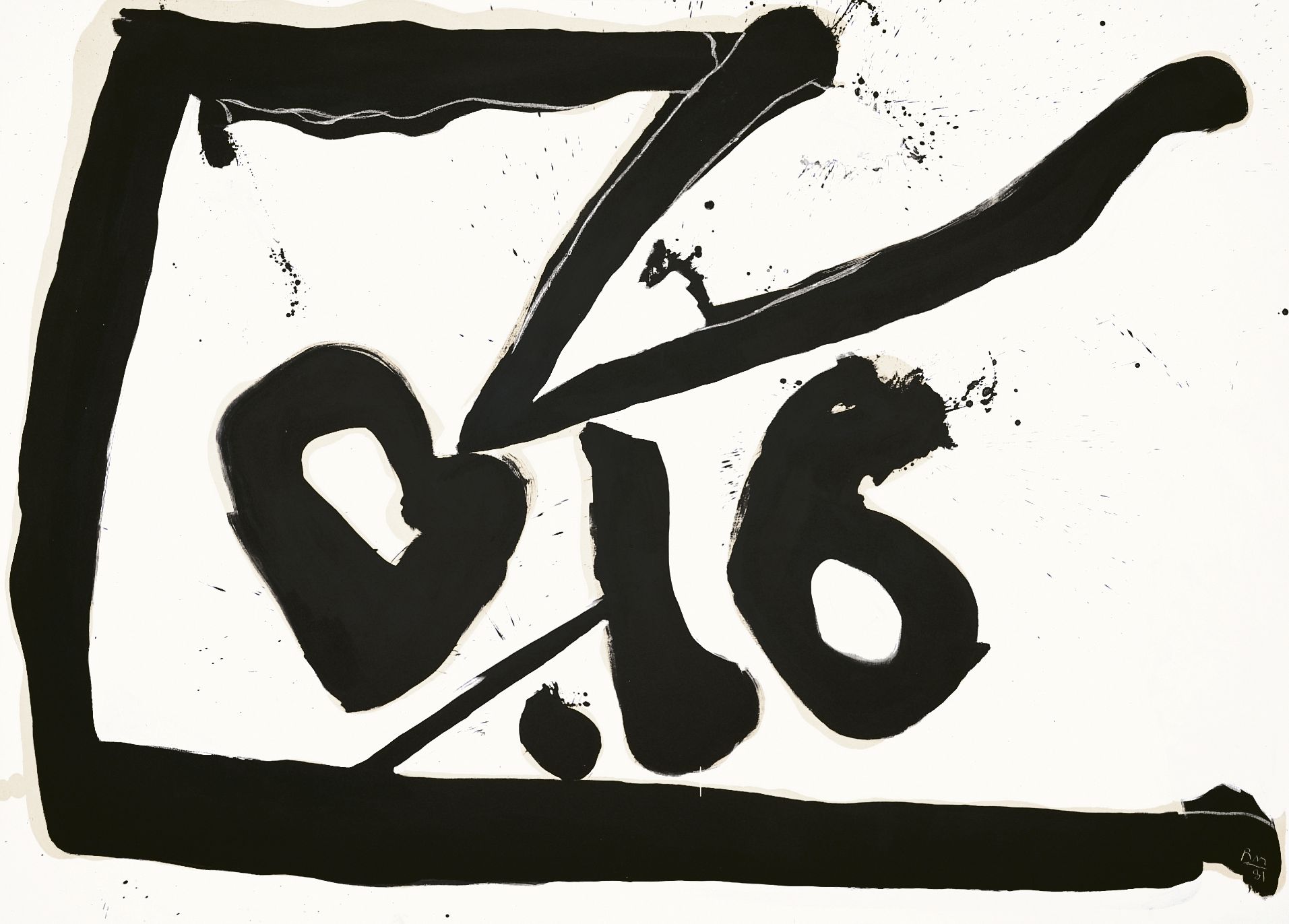

1981
Motherwell is awarded the Skowhegan Medal for Printmaking.
Motherwell begins Signs on a White Field, the first in a series of canvases in which he enlarges images from the Drunk with Turpentine series to a monumental scale and gives them titles derived from Joyce’s Ulysses. He exhibits a number of these works at the Knoedler gallery the following year.
A revised edition of H.H. Arnason’s 1977 monograph Robert Motherwell is published by Harry N. Abrams. The new volume includes an essay by Dore Ashton, an interview with Motherwell by Barbaralee Diamonstein, and poems by Rafael Alberti, Barbara Guest, and Octavio Paz.
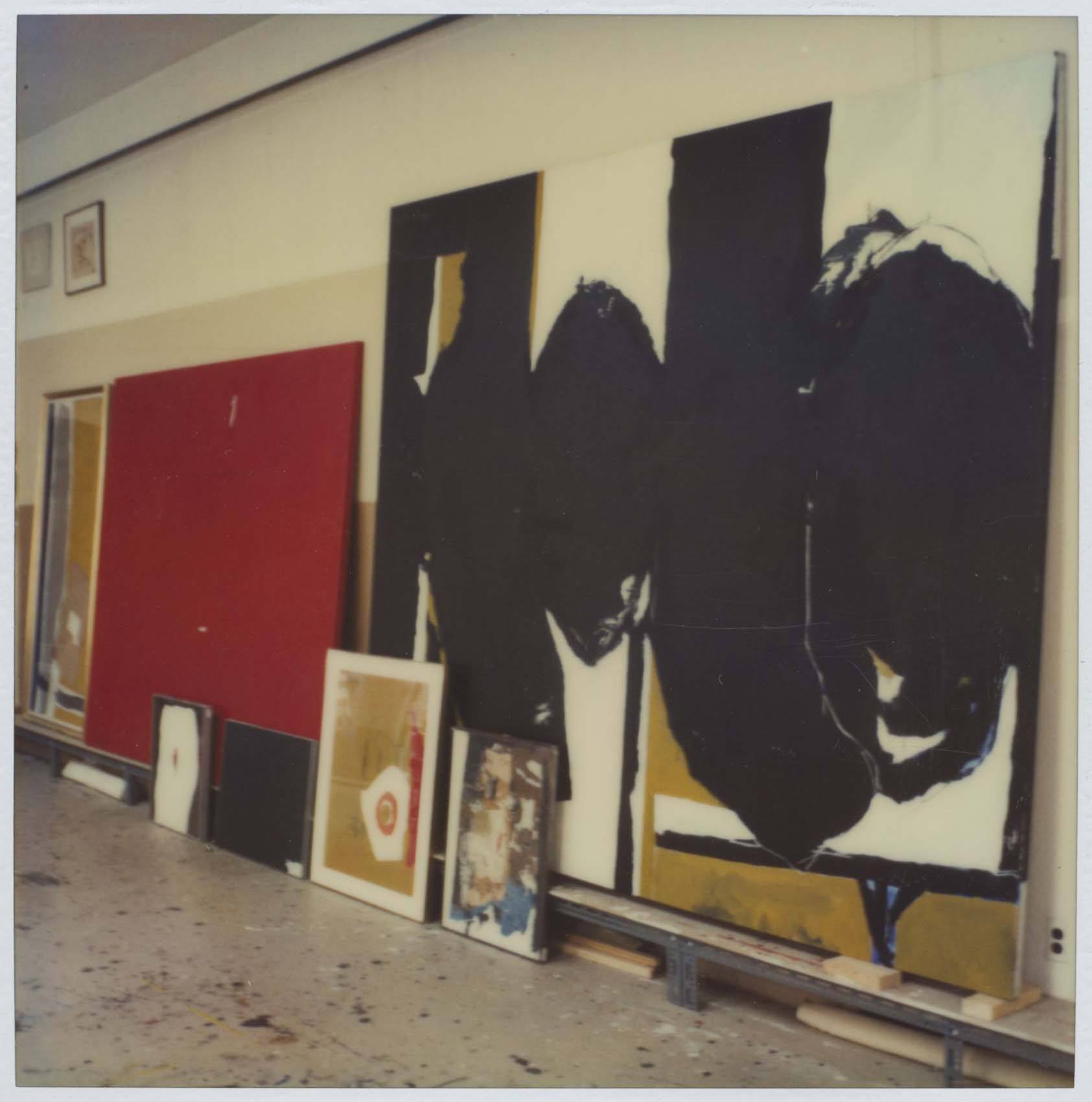
Motherwell’s Greenwich studio showing selections of work intended for the “Motherwell Room” at the Bayerische Staatsgemäldsammlungen, Munich, 1982
1982
In November, Motherwell travels to Munich for the opening of the “Motherwell Room” at the Bayerische Staatsgemäldsammlungen, Staatsgalerie für Moderne Kunst. The museum acquires a group of ten representative works that are to remain on permanent view.
1983
In January, Motherwell’s daughter Jeannie gives birth to his only grandchild, Rebecca.
Motherwell receives the Gold Medal for the Visual Arts from the National Arts Club.

The Hollow Men, 1983. Acrylic, charcoal, and graphite on canvas, 88 x 176 inches (223.5 x 447 cm)
1983
In the spring, Motherwell paints The Hollow Men, the first work in what becomes his major new series of the 1980s.
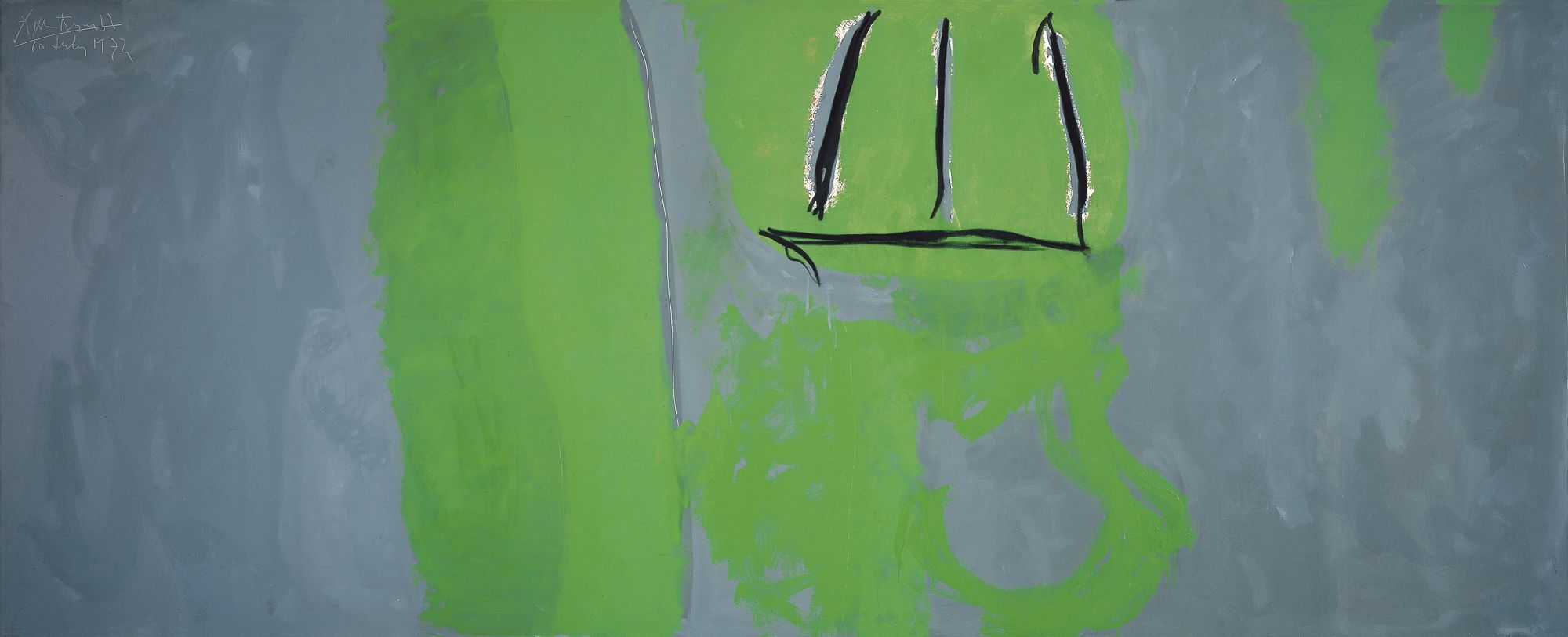
Riverrun, 1972/1973/1982–1983. Acrylic and charcoal on canvas, 60 x 150 inches (152.4 x 381 cm)
1983
During the summer, Robert Motherwell: Tribute to James Joyce is presented at the Provincetown Art Association and Museum and includes works such as Riverrun.
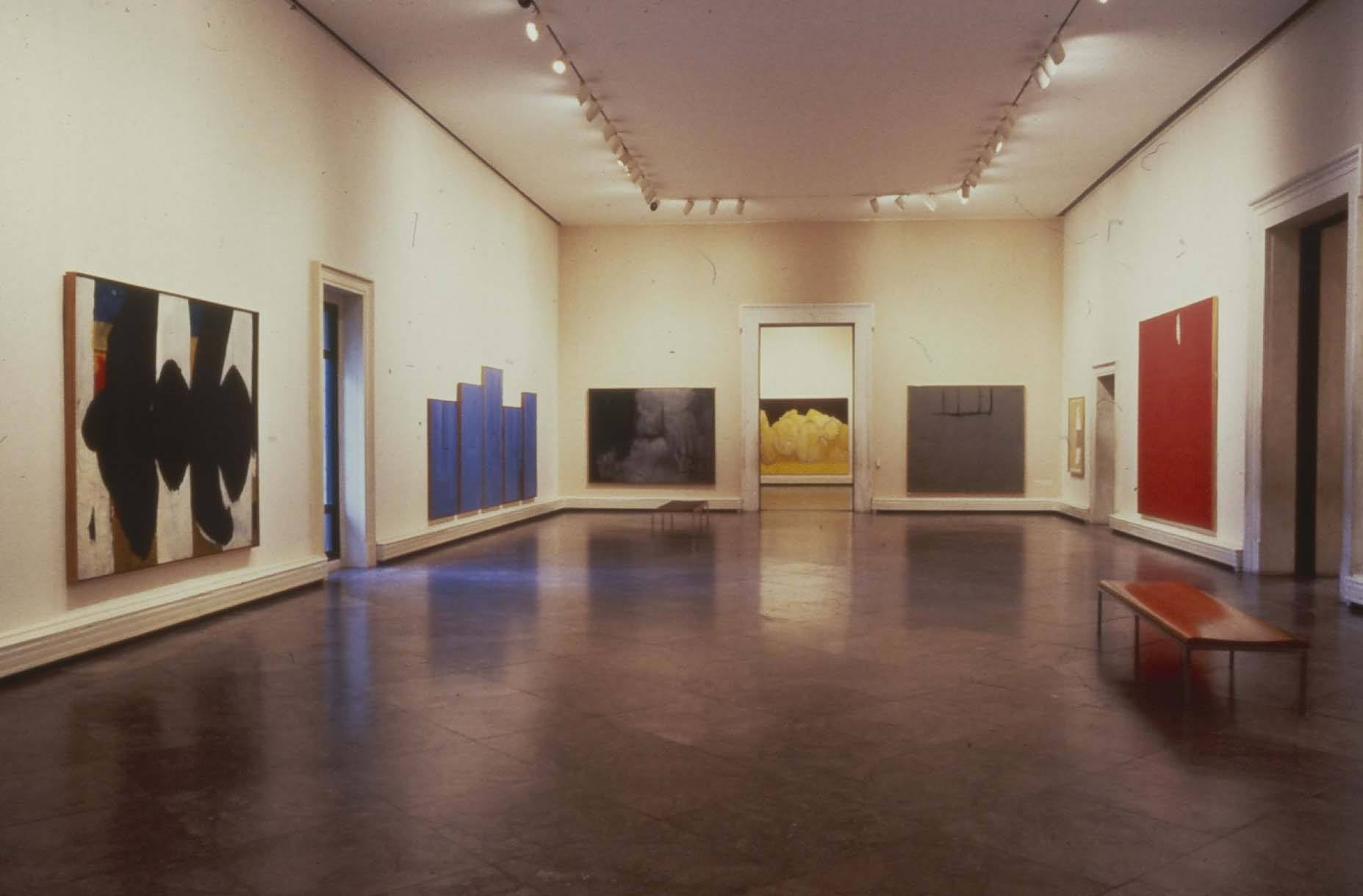
Installation view of Robert Motherwell at Albright-Knox Art Gallery, Buffalo, 1983
1983
In the fall, the Albright-Knox Art Gallery presents Robert Motherwell, the first full-scale retrospective of his work in the United States since 1965. The exhibition subsequently travels to Los Angeles, San Francisco, Seattle, Washington D.C., and finally to New York, where it is expanded and includes drawings.
1984
Motherwell creates over twenty-five print editions during the year with Mosley and Tyler Graphics. His printmaking informs many of his collages, in which he introduces torn fragments from print proofs, while many of the prints are based on collages.
1985
In the spring, Motherwell and Andrew Hoyem of Arion Press begin work on a livre d’artiste of James Joyce’s Ulysses.
During the summer, he creates a number of new works in the Hollow Men series.
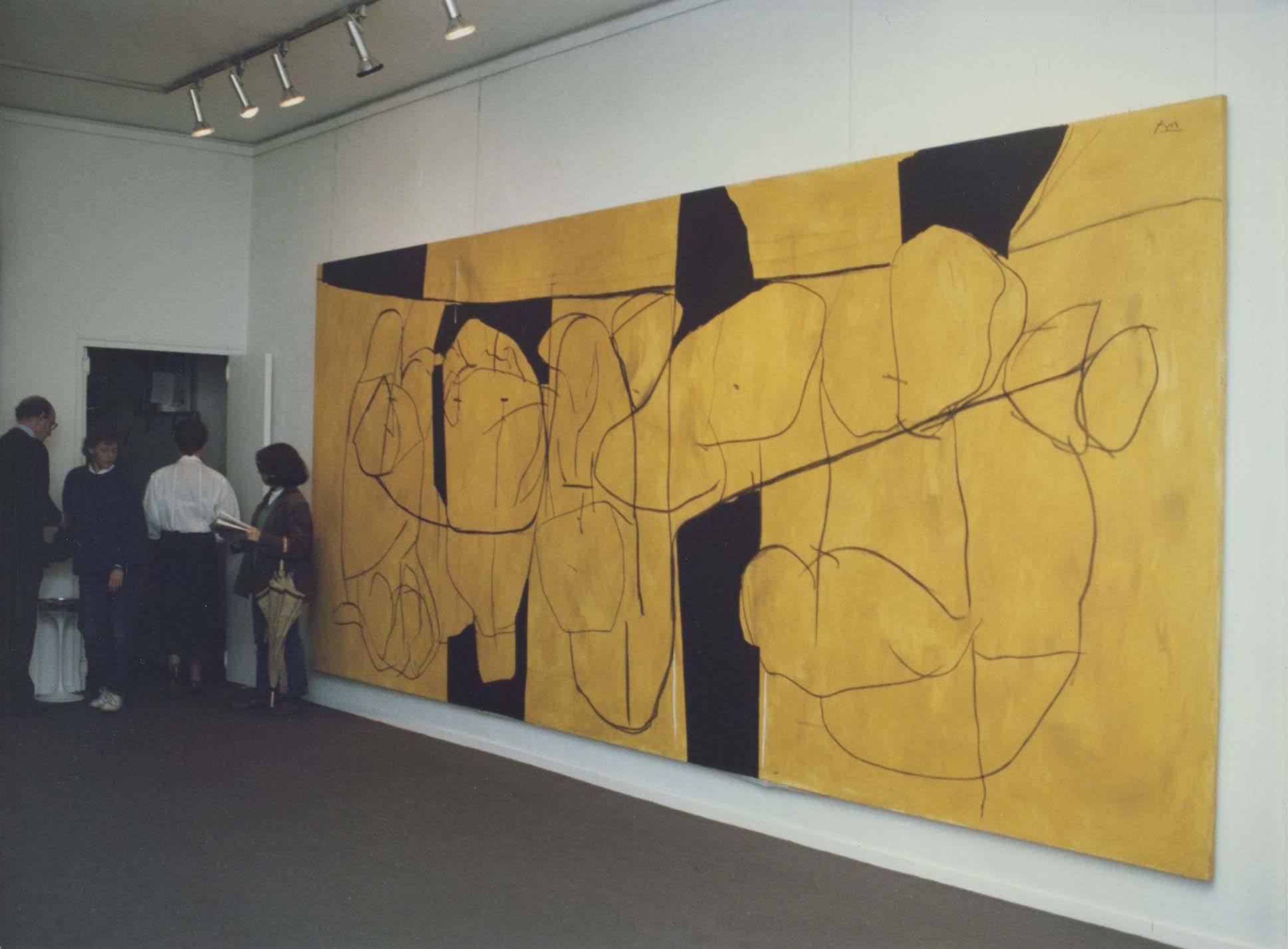
Installation view of the traveling exhibition Robert Motherwell, Galería Juana Mordo, Madrid, 1987
1986
In October, Robert Motherwell, an exhibition at the Galería Joan Prats, opens in Barcelona. It shows a number of large paintings, including The Golden Bough. It travels to Palma de Mallorca, Bilbao, and Madrid.
Motherwell receives the Medalla de Oro de Bellas Artes, the highest cultural award in Spain.
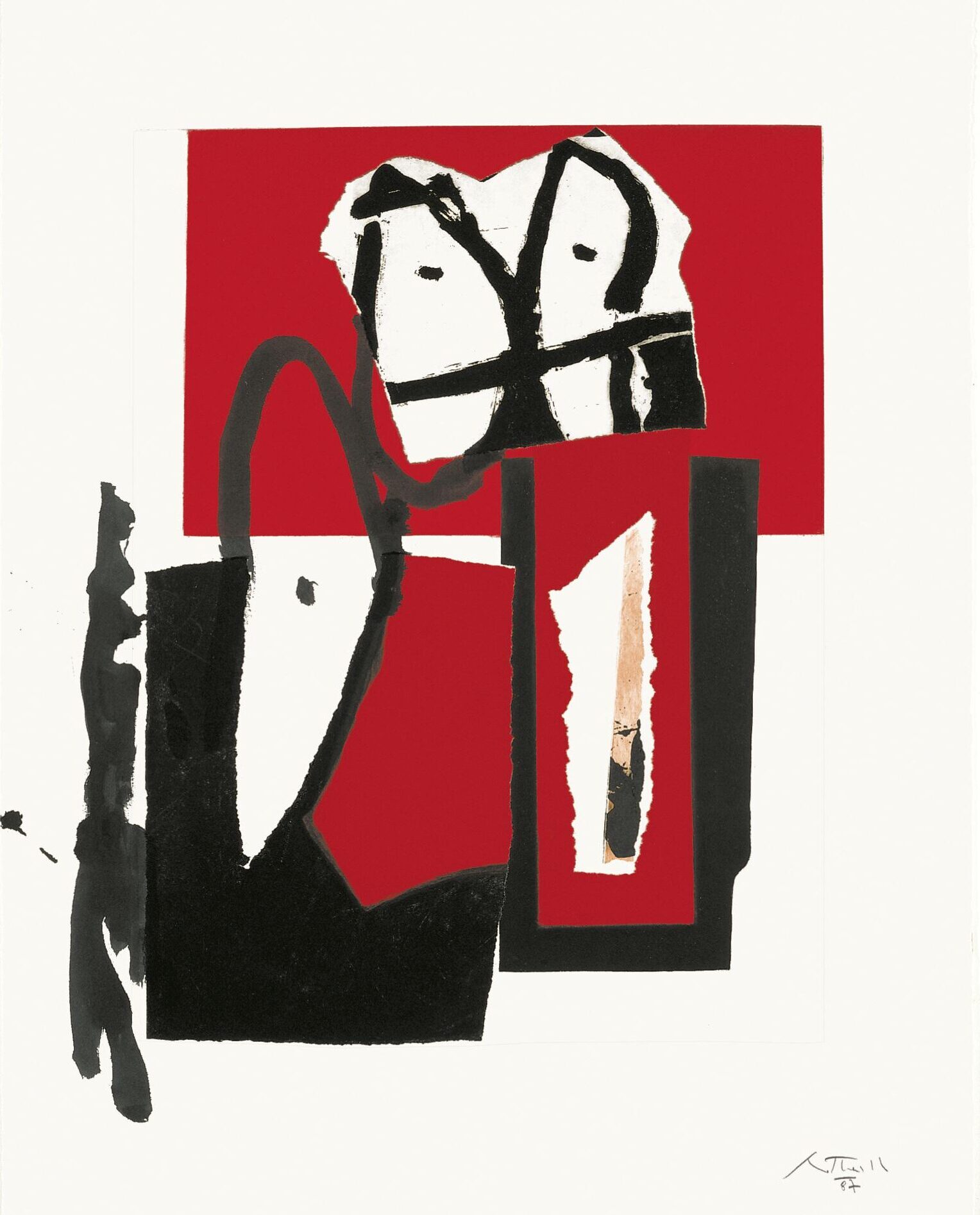
The Red and Black No. 6, 1987-88
1987
Motherwell tears a muscle in his arm and shoulder and is unable to paint.
In August and September, working with Catherine Mosley, he creates The Red and Black Series, fifty-six collages that share the same printed ground.
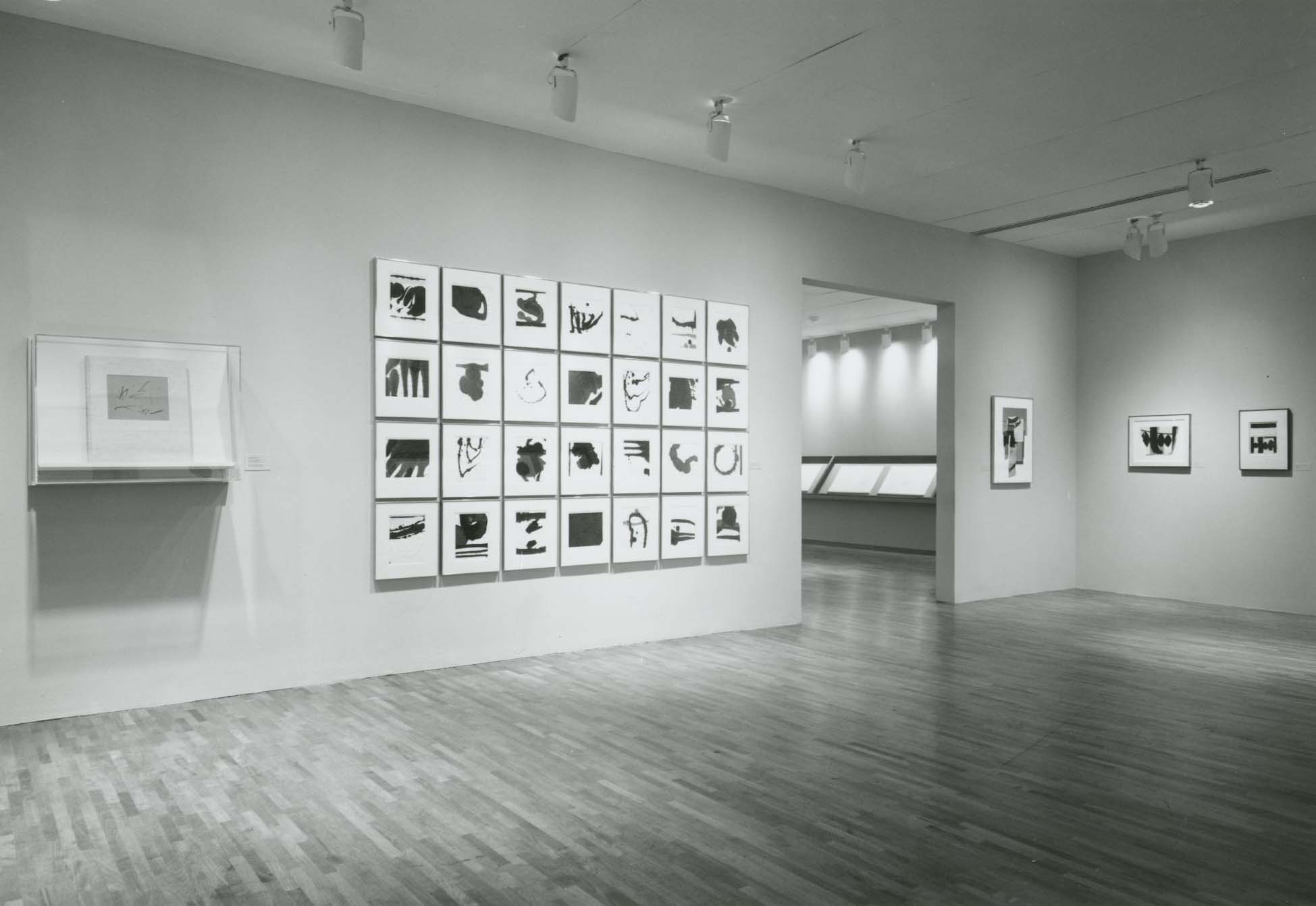
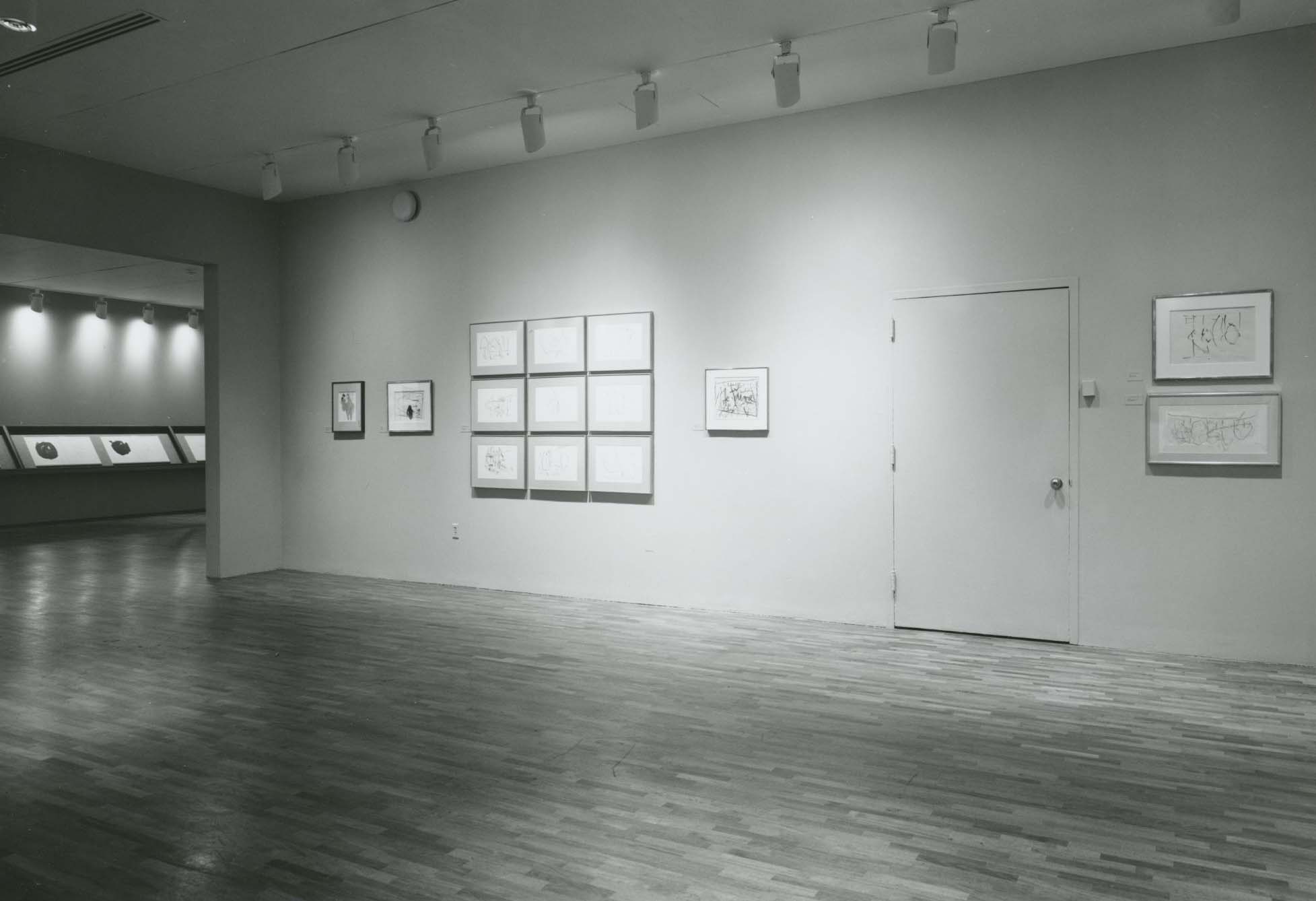
1987
In the fall, Abstract Expressionism: The Critical Developments, curated by Michael Auping, is presented at the Albright-Knox Art Gallery. The exhibition includes five works by Motherwell.
The Museum of Modern Art presents Gifts of Works on Paper by Robert Motherwell, an exhibition of thirty-seven works donated to the museum by Motherwell. Among the works donated, which are drawn from all periods of his career are The Mexican Sketchbook, Elegy to the Spanish Republic No. 1, and Crayon Je t’aime.
In December, Motherwell agrees to provide a large painting for the new corporate headquarters of General Electric in Fairfield, Connecticut.
1988
L’Atelier de Robert Motherwell, a documentary for French television by Benoît Jacquot, is filmed in Greenwich for broadcast in 1989.
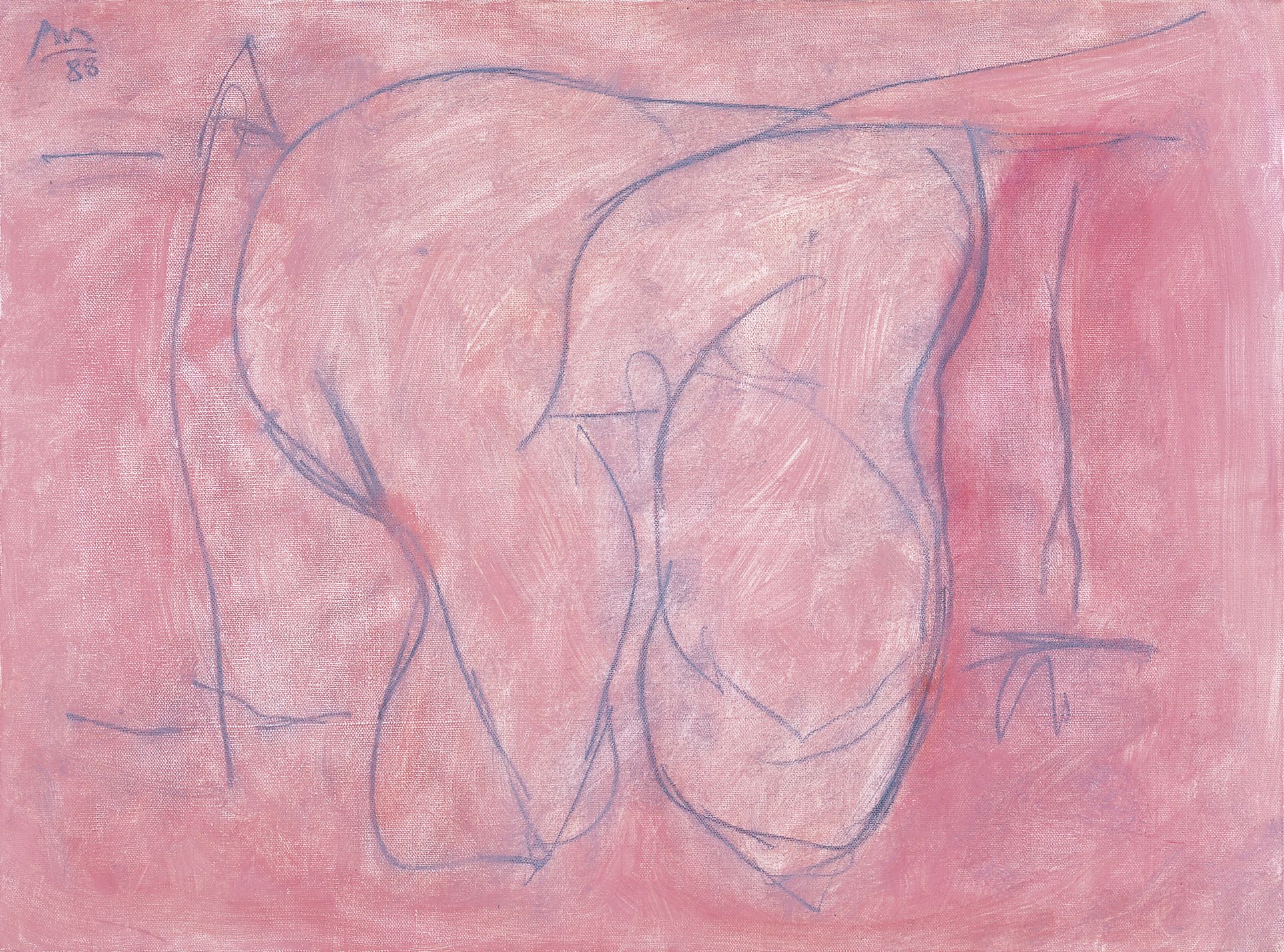
The Feminine I, 1988
1988
During the Summer, while undergoing physical therapy on his shoulder, Motherwell creates only one new painting in Provincetown, The Feminine I. He also revises many of the previous summer’s The Red and Black collages.
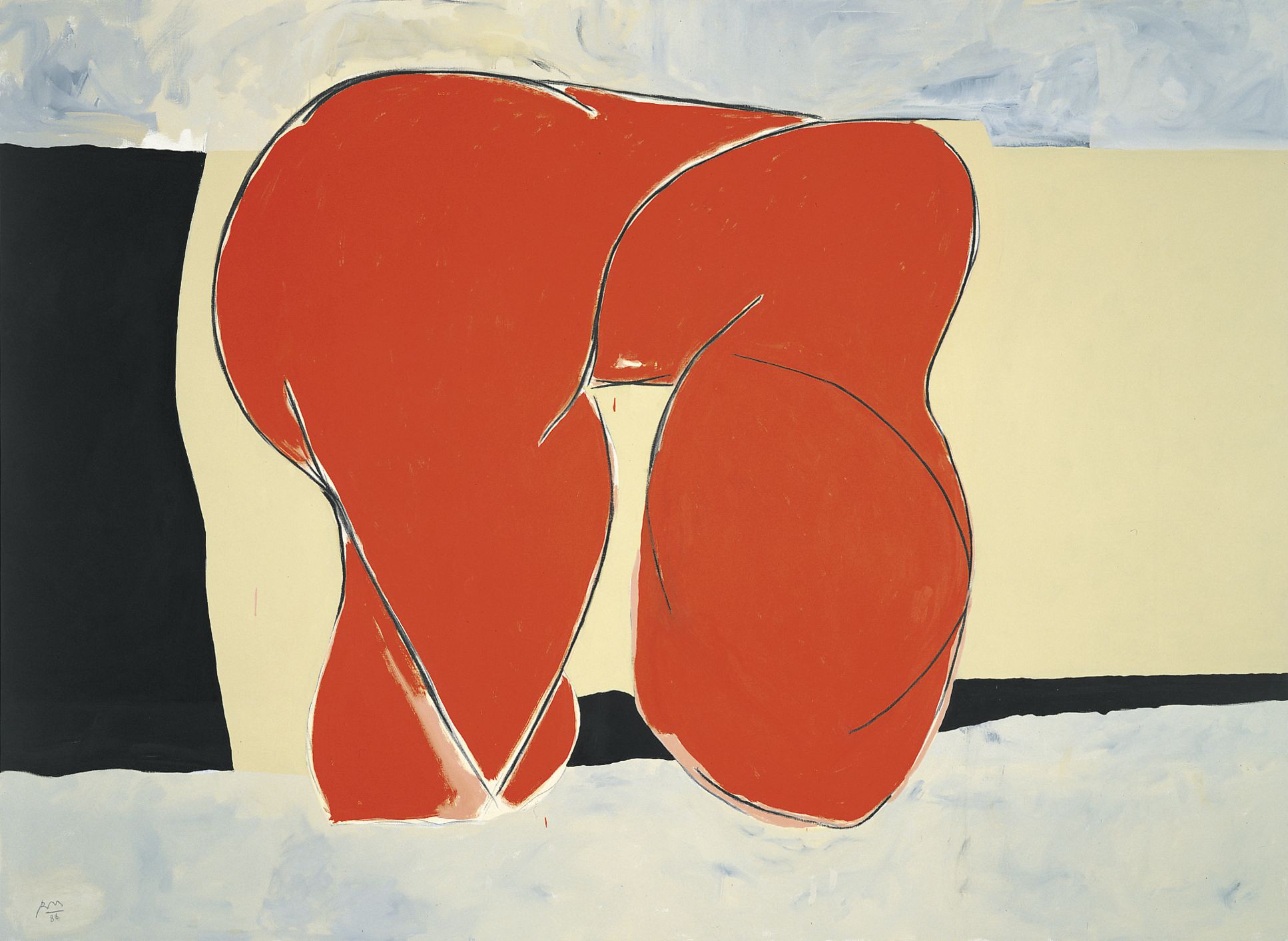
The Feminine II, 1988
1988
In the fall, his physical health restored, Motherwell has a period of renewed activity. He creates the livre d’artiste Three Poems, with poetry by Octavio Paz, and a number of large paintings, including The Feminine II, Primal Image, and A Rose for James Joyce.
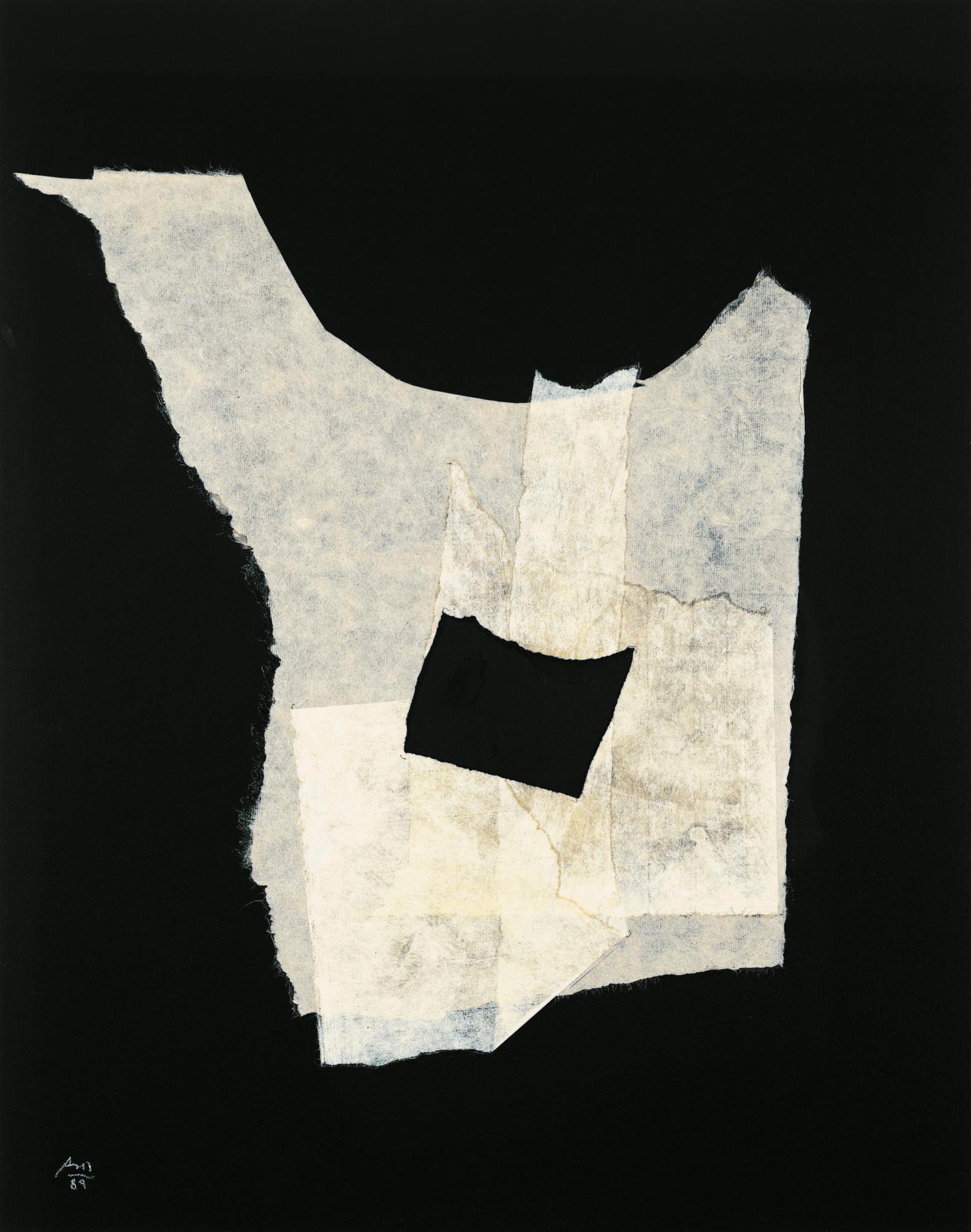
Night Music Opus No. 16, 1988
1988
Later in the year, Motherwell paints Elegy to the Spanish Republic No. 171 and creates twenty-five collages in the Night Music Opus series, his last sustained series of collages. The collages are shown at the Knoedler gallery the following year.
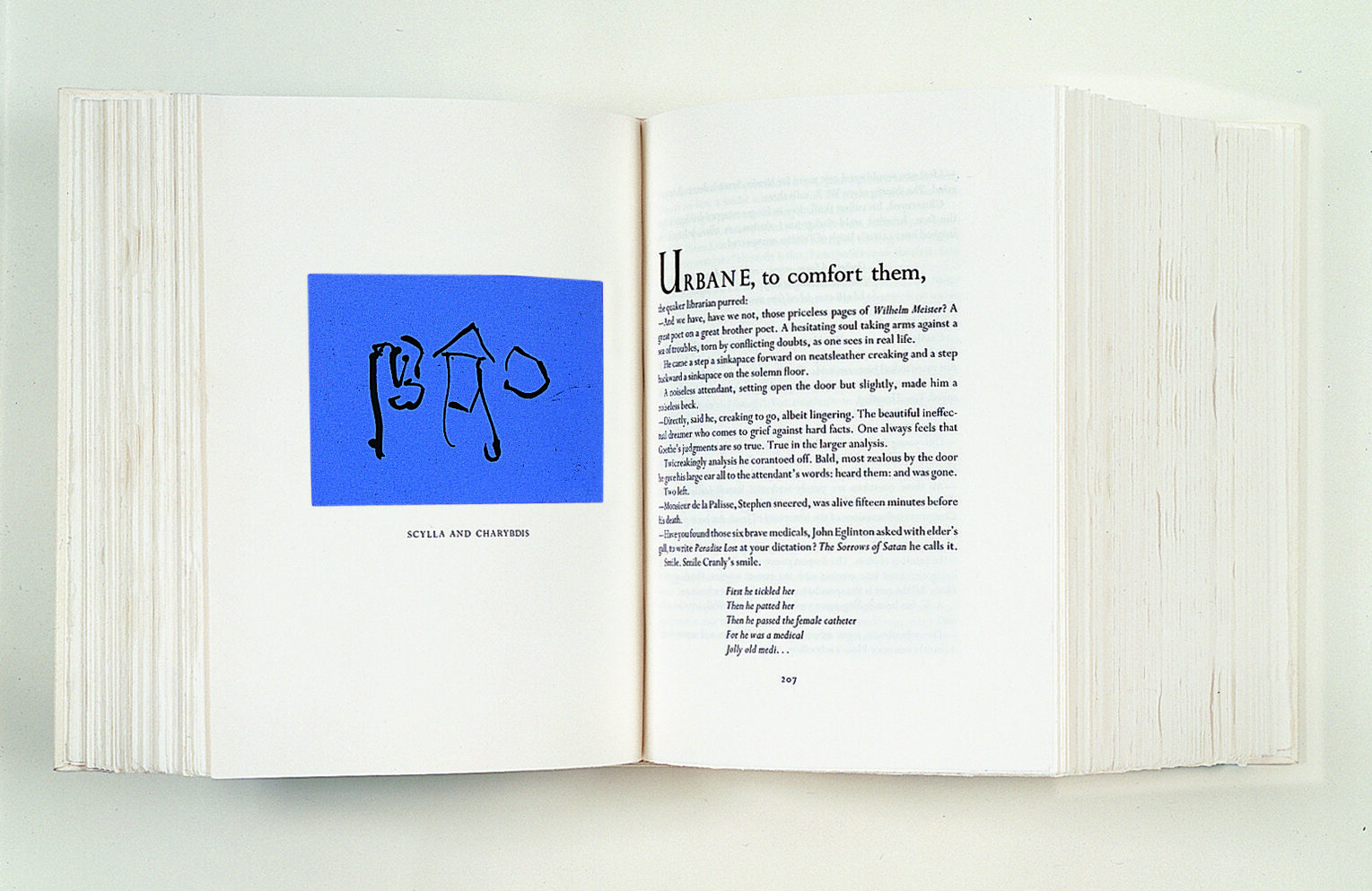
Page of Ulysses with etching Scylla and Charybdis by Motherwell, 1988
1989
In the spring, Motherwell’s livre d’artiste of James Joyce’s Ulysses is published by Arion Press.
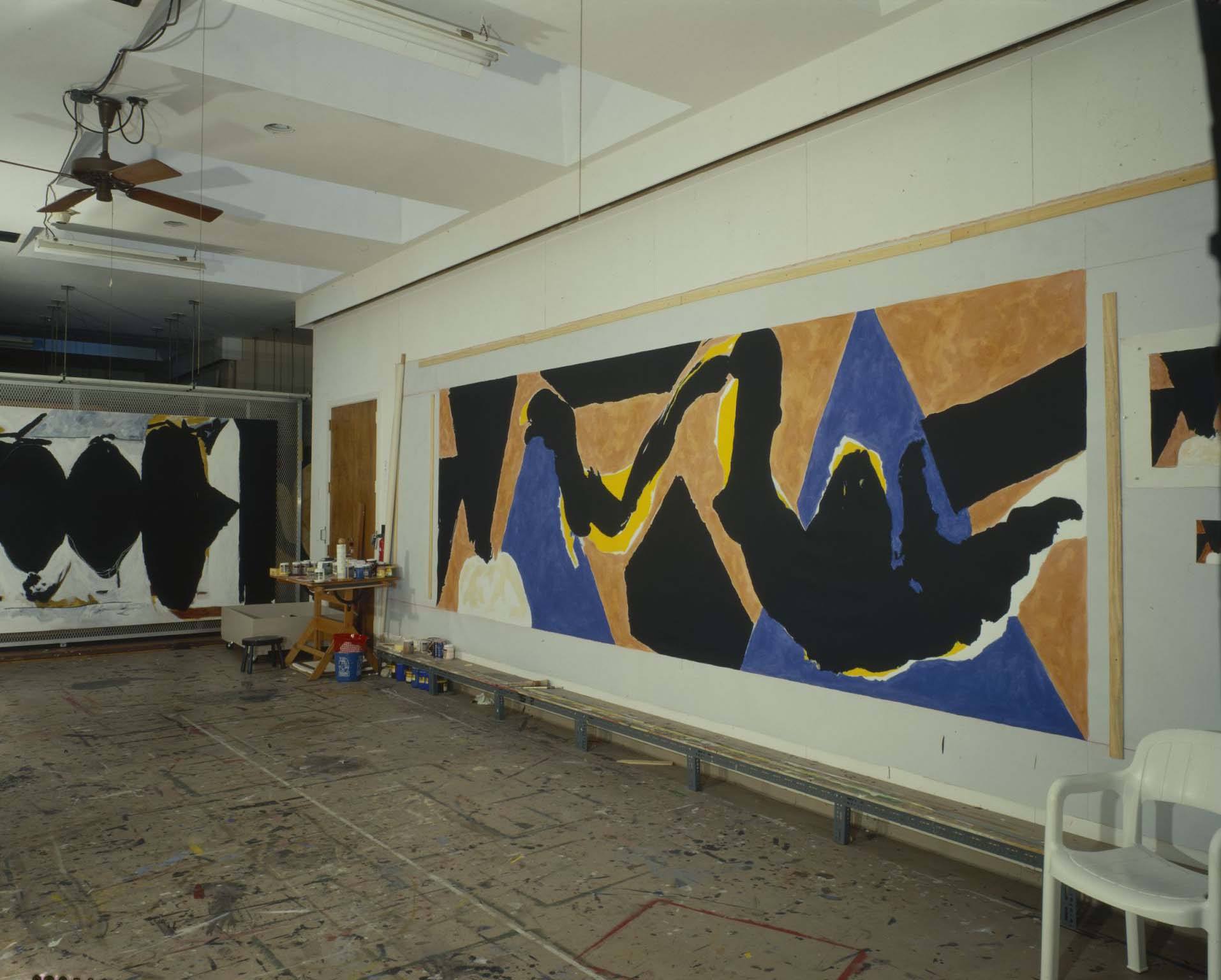
Motherwell’s Greenwich studio with Arabesque in progress, October 1989
1989
Motherwell undergoes surgery to repair damage to his shoulder. During his recovery he focuses on printmaking with Catherine Mosley in Provincetown.
By August, his health restored, he returns to painting and completes the studies for the General Electric mural.
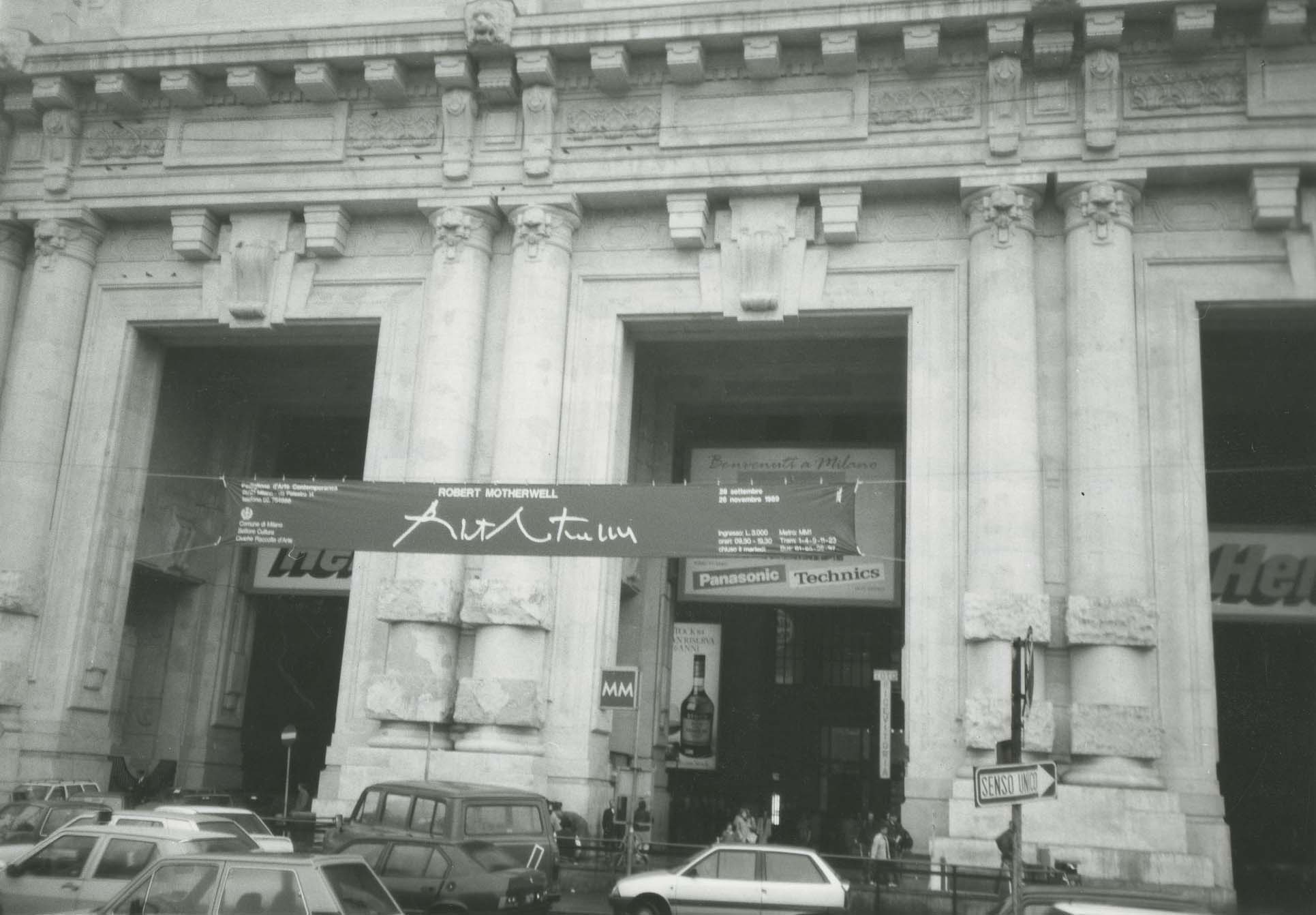
Exhibition banner outside Robert Motherwell, Padiglione d’Arte Contemporanea, Milan, September 1989
1989
In the fall, Robert Motherwell, a retrospective exhibition curated by Dore Ashton, is shown at the Padiglione d’Arte Contemporanea, in Milan.
1989
John Frohnmayer, chairman of the National Endowment for the Arts, withdraws a $10,000 grant to the New York gallery Artists Space because of controversy surrounding its exhibition Witnessing: Against Our Vanishing, a show of art about AIDS. On learning of the controversy, Motherwell privately donates $10,000 to Artists Space, to cover its loss of funding.
In November, President George H.W. Bush presents Motherwell with the National Medal of Arts in a ceremony at the White House. Other recipients include Alfred Eisenstaedt, Martin Friedman, Dizzy Gillespie, Czeslaw Milosz, and John Updike.
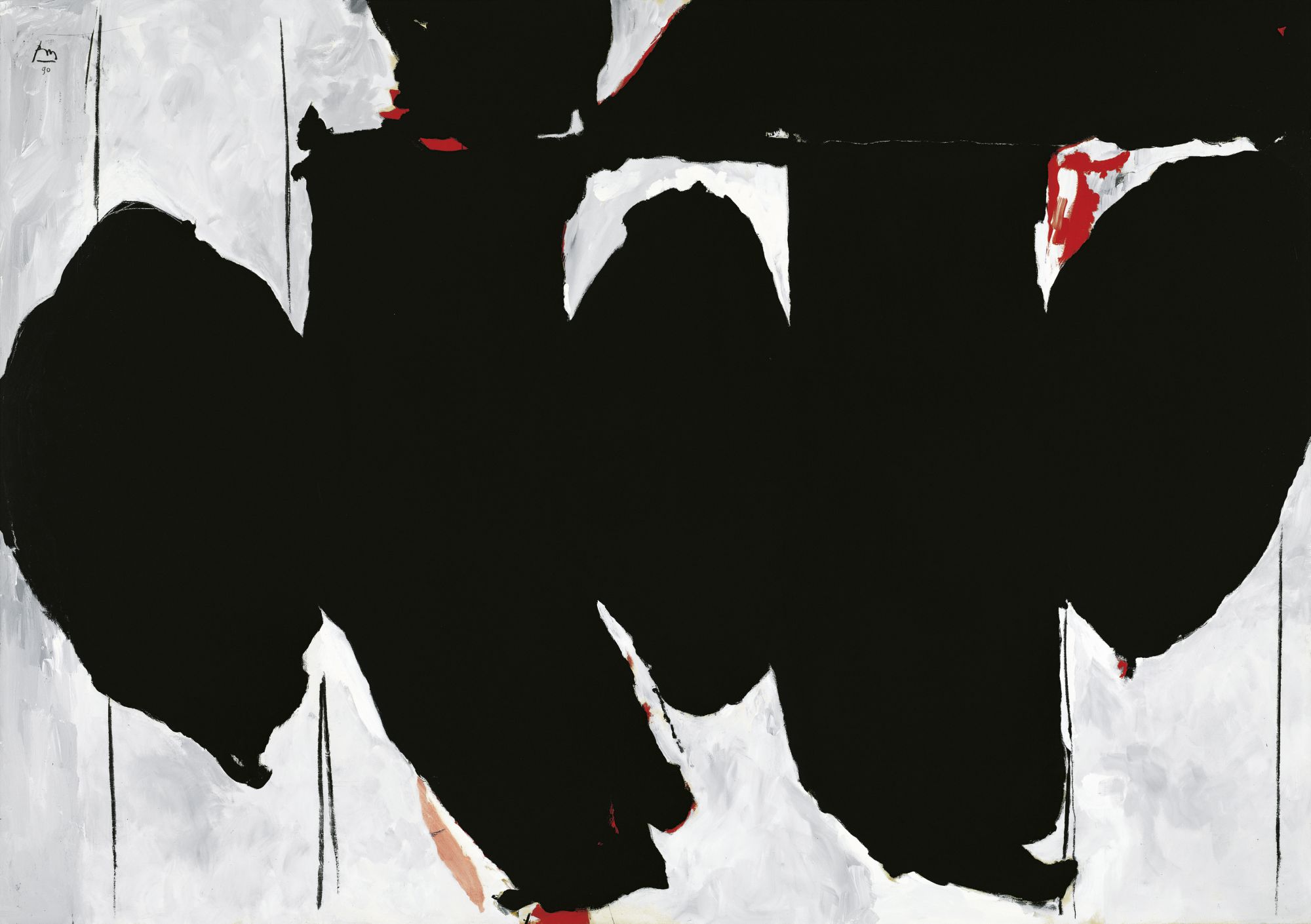
Elegy to the Spanish Republic No. 172 (with Blood), 1989–1990. Acrylic and oil stick on canvas, 84 x 120 inches (213.4 x 304.8 cm)
1990
During the Spring, Motherwell completes his last major group of Elegy paintings, including Elegy to the Spanish Republic No. 171 and Elegy to the Spanish Republic No. 172 (with Blood).
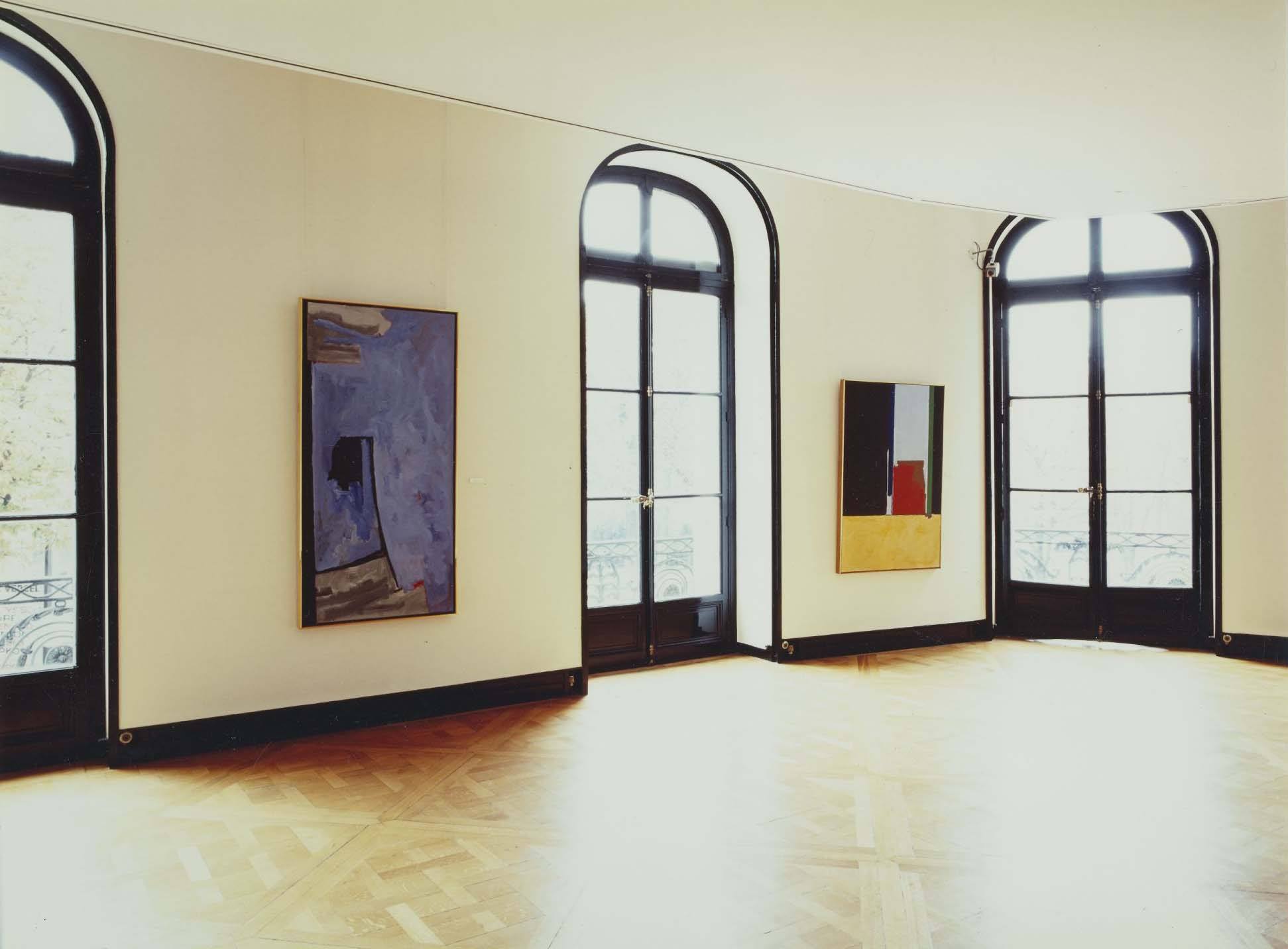
Installation view of Robert Motherwell: Peintures et collages, 1969–1990, Artcurial Centre d’Art Plastique Contemporain, Paris, September 1990
1990
In the fall, Robert Motherwell: Peintures et collages 1969–1990 is presented at Artcurial Centre d’Art Plastique Contemporain, Paris. The exhibition includes twenty-seven paintings and collages, including the recently completed Elegy to the Spanish Republic No. 171 and Elegy to the Spanish Republic No. 172.
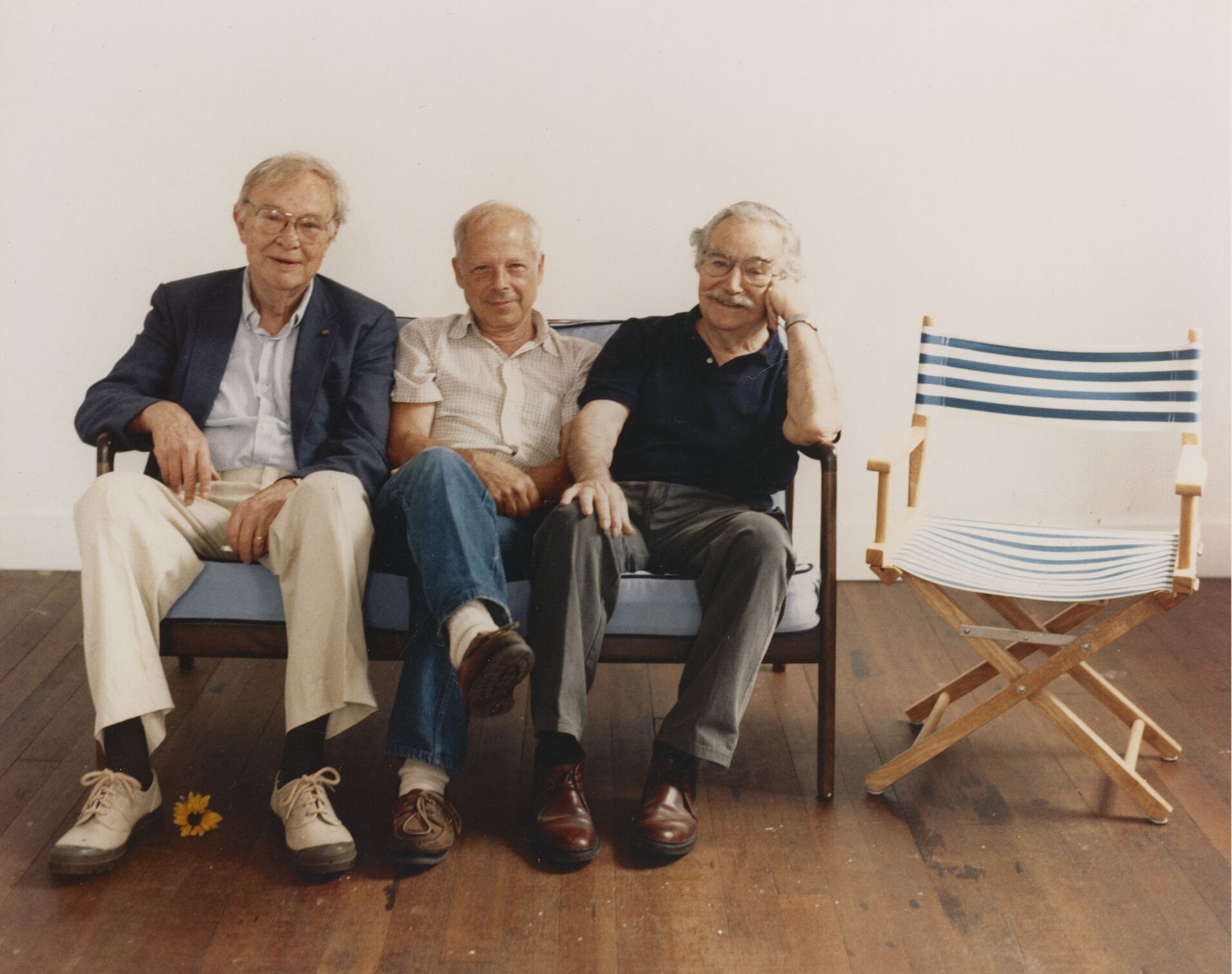
Motherwell (left) with fellow Long Point Gallery artists Ed Giobbi and Leo Manso, summer 1990
1990
On October 12, Motherwell suffers a minor stroke and is hospitalized for four days. His doctor warns him that he must quit drinking and smoking entirely; but he can do neither in the months that follow. The stroke slightly affects his walking and generally slows him down physically, and he undergoes a period of physical rehabilitation before he can return to work.
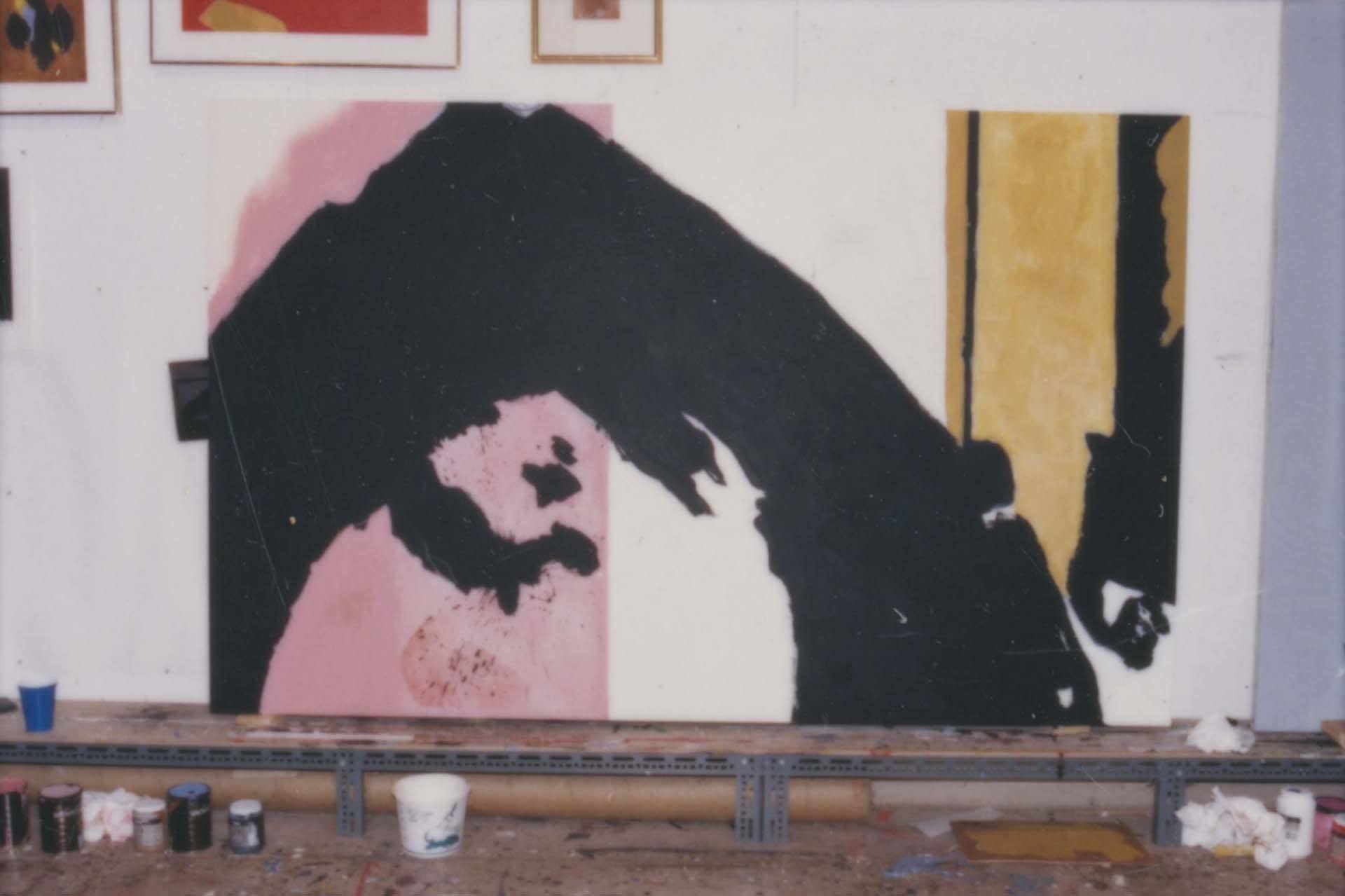
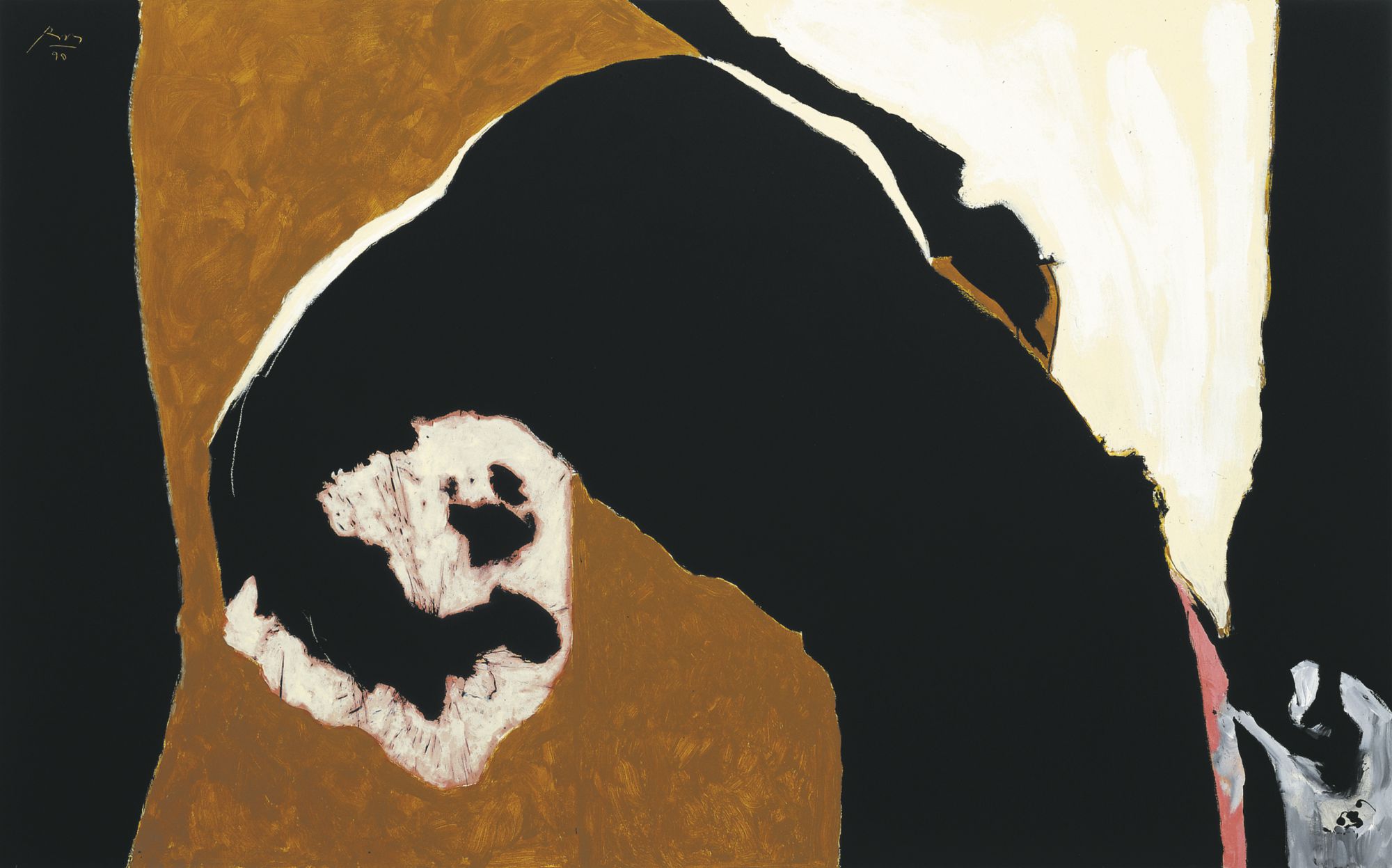

Burning Elegy, 1991
1991
In the early months of 1991, with exhibitions planned for Knoedler & Company in April and a retrospective planned for September in Mexico City, Motherwell returns to work with great urgency. During these months he completes ten new paintings, including three large-scale canvases, Mexican Past, Either/Or (for Kierkegaard), and Massive Image, and his final large Elegy painting, Mourning Elegy.
He also creates the 53-by-61-inch lithograph Burning Elegy, his largest Elegy print.
1991
During the spring, he has what will be his last exhibition at the Knoedler gallery, Robert Motherwell: From the Studio, which presents thirty-two new works done between 1958 and 1991, including his recent large-scale canvases, Improvisation, Mexican Past, Either/Or (for Kierkegaard), and Massive Image.
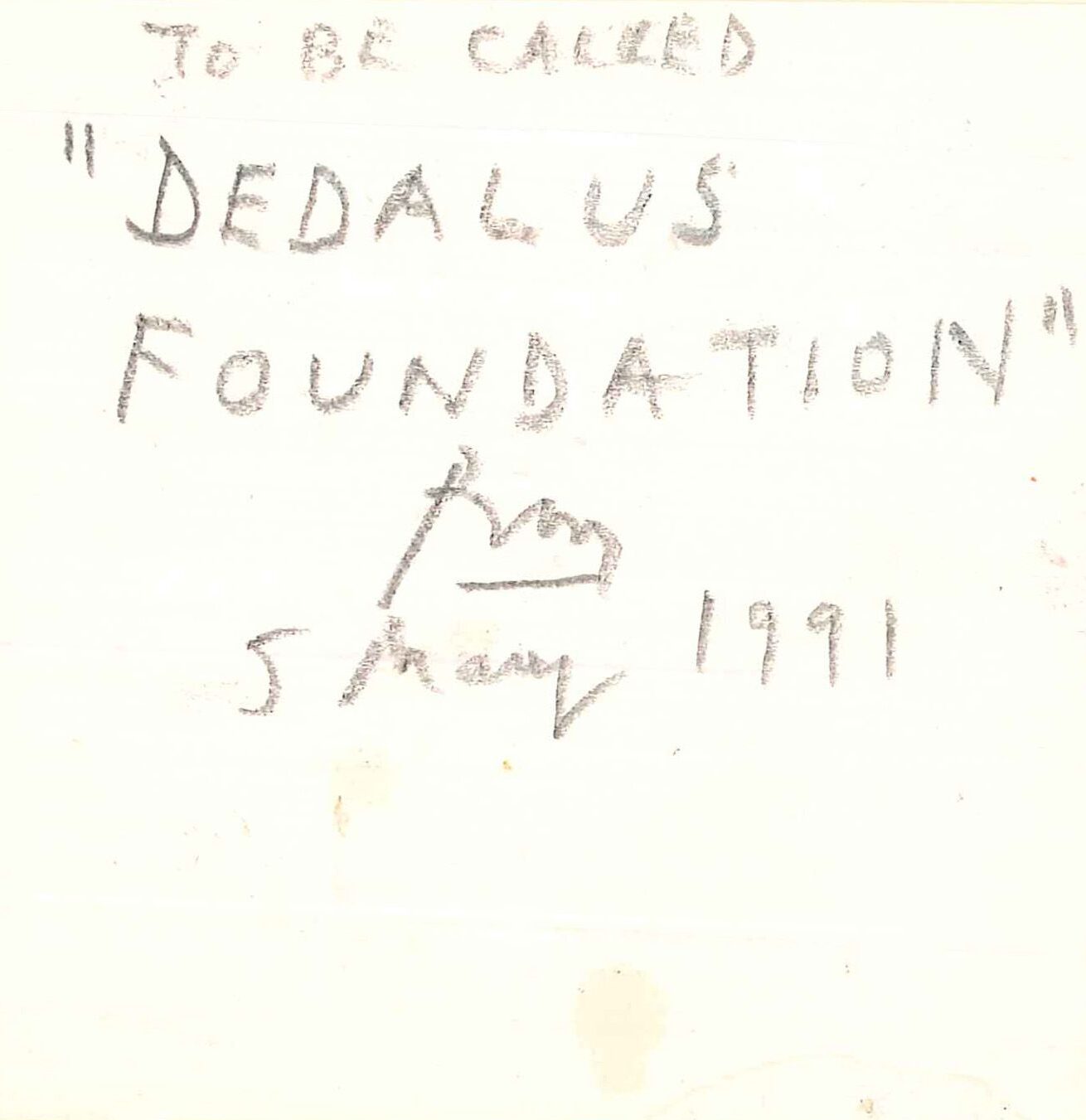
Note from Motherwell regarding the naming of his foundation, May 1991
1991
In the spring, Motherwell renames the Motherwell Foundation the Dedalus Foundation, after Stephen Dedalus, the protagonist in James Joyce’s A Portrait of the Artist as a Young Man and Ulysses, with whom he deeply identifies.
On July 16, at home in Provincetown, Motherwell suffers a major stroke. An ambulance rushes him to the hospital, but he dies of heart failure en route.

